Leotax
Nicca's rival
.jpg)
Contents
(Scroll down or click on Links)
The Leotax Story
“Made in” and Other Markings
The Models
The Original Leotax
Leotax Original
Leotax Special A & Special B
Leotax Special
Leotax Special D II & Special D III
NR III
Leotax D IV
Leotax S
Leotax F
Leotax T (Leotax F based)
Leotax K (Leotax F based)
Leotax TV
Leotax T2 (Leotax TV based)
Leotax K3 (Leotax TV based)
Leotax FV
Leotax TV2, later Merite (aka Merit, Leotax FV based)
Leotax T2L, later Elite (Leotax FV based)
Leotax Elite S2 (Leotax FV based, Merite with Leonon-S lens)
Leotax G
The Late f/2 Topcor-S, Leonon & Leonon-S Lenses
Lenses Overview
Letana (Fujita)
State, C.Simlar, Simlar & Topcor (Tokyo Kogaku)Zuiko (Olympus)
Hexar & Hexanon (Konishiroku, later Konica)
Fujinon (Fuji Photo Film)
Elmar vs Tessar
Viewfinder and Rangefinder Die-cast Models
Shutter Speed Dials
Flash Sync
Accessories
Lens Caps
Ever-ready Cases
Reloadable Film Cassettes
Filters
Lens Hoods
Flashgun
User Manuals
1957 Prices
The Biggest & Heaviest
Contact Details
The Leotax Story
According to Sugiyama (page 47, story repeated in Camera-wiki.org), former Konishiroku (later day Konica) engineer Kanzo Nakagawa founded the company that eventually became Leotax as Kyōei-sha in Nippori, Tokyo in January 1938. Encouragement and funding came from Minagawa Trading. Minagawa was the distributor of First cameras and features very briefly in Tokiwa Seiki, a Late Pigeonflex Recruit on the Pigeon Loft page of my Yashica TLR site.
Kanzo Nakagawa apparently had a fondness for Leica cameras and decided to base his first camera on the Leica III. Sugiyama tells us that it turned out almost identical but that the rangefinder was uncoupled (I suspect it was more a Leica II copy, certainly the following two versions were without slow speeds). The name decided on was “Letax” from Leica and Nettax but when it couldn't be registered was changed to “Leotax”. The Nettax was a Zeiss Ikon made interchangeable lens 35 mm rangefinder camera, introduced in 1936, which sat below the company's premium Contax II model. After the prototypes had been made and tested, Kyōei-sha changed its name to G.K. Shōwa Kōgaku (Showa Optical Works).
Low level production continued into late 1940 when the original “Leotax” production version was redesigned into what collectors somewhat erroneously now call the “Leotax Original” (see below), still with uncoupled rangefinder. Also in 1940, Shōwa Kōgaku launched the 4.5 x 6 cm Zeiss Nettar based “Semi Leotax” folding camera with subsequent versions (the “DL” and “R”) remaining in production until 1955. According to Camera-wiki.org, this was Shōwa Kōgaku's main production activity in the early days with an estimated 15,000 produced during the War years. There was also a 3 x 4 cm “Baby Leotax” folder released in 1941, according to Sugiyama, but it is little known and didn't appear to survive the War. Below left is an early Semi Leotax, the auto-stop film winding mechanism visible on the camera bottom indicates War-time production, as does the Fujita made Rieze-Anastigmat lens and New Torio shutter, on the right, a 1950's R model with rangefinder:
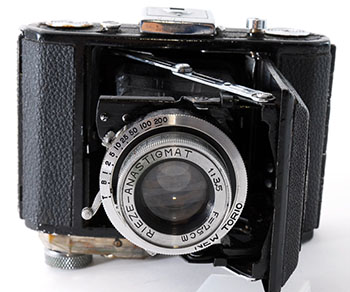
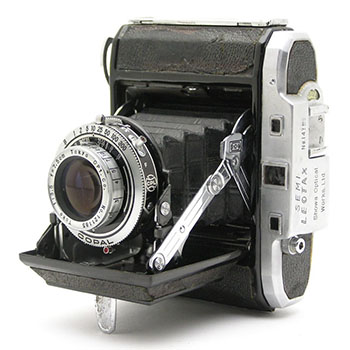
(Detail from larger web images)
The Leotax Special A and B models, now with a coupled rangefinder with an unusual design which circumvented Leica patents, followed in 1942 and a version of the A, the “Leotax Special” was the first post-War release in 1946. Sugiyama tells us that Shōwa Kōgaku had relocated to a safe area during the War and was able to resume production very quickly. Also at some point after the War, the company changed its name to Shōwa Kōgaku Seiki K.K. (Camera-wiki.org).
In 1947, with Leica patents effectively cancelled by the Allies as War reparations, the rangefinder was finally redesigned along Leica lines and the Special A and B morphed into the Special D II and D III. Possibly in 1948 or 1949, the maker name engraving on the late version of the Special D III changed to “Showa Optical Company limited” from the “Showa Kogaku” found on previous models. In 1950, with the introduction of the Leotax D IV, the engraving changed to “Showa Optical Works, Ltd.”
Also, just beforehand in November 1949, Leotax released the unusual, and now collectible, subminiature Gemflex pseudo TLR. It was advertised in 1950 but didn't seem to enjoy a long run.
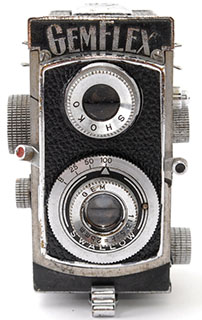 (Detail from larger web image)
(Detail from larger web image)
Up to this point, Leotax cameras had been playing somewhat second fiddle to arch rival Nicca but in 1954, the company beat Nicca to market with a completely redesigned camera based on the die-cast Leica IIIf (pre-War IIIc with flash sync). Eventually, there were were three generations, the second featuring an improved viewfinder and the third introducing lever wind, with several price point variations of each achieved by stripping specs and/or features.
In 1956, the company name changed to “Leotax Camera Co., Ltd.”, also reflected by the maker name engraving.
However, the market place was starting to become difficult for all the Leica copy makers. Canon, with the advantage of being both camera and lens maker, was innovating and growing and also cleverly segmenting the market with different feature mixes for different price points. The Leica M3 spurred on both Canon and Nikon to innovate more and at the same time, the rise and rise of the SLR had begun.
Nicca succumbed in 1958. Japanese Wikipedia tells us that Leotax went bankrupt in 1959, coincidently in the same year that Canon released its second most successful rangefinder model, the Canon P, with its most successful model, the Canon 7, yet to come. Mikio Awano in an article in Japanese magazine Camera Collectors' News, September 1978 edition, narrows it down to October 1959 even though the last model based on the Leica IIIf design, the Elite S2, was apparently not released until 1960. Somewhat like Nicca with its III-L model, Leotax had been working on what it thought was a modern interpretation of the LTM rangefinder and had already produced parts for the initial batch. Sadly, when the Leotax G was released in 1961, assembly had been completed by a sub-contractor.
Whereas in the beginning, Leotax was simply interested in making Leica-like cameras for customers starved of the real thing because of the War and the aftermath, as the market matured and segmented, it seemed to concentrate more on the amateur end, or at least was pushed that way by Canon and Nikon. The range of accessories was limited, as were the available Topcor accessory lenses.
Ironically, more seems to be known about the company's origins than its later day operations. I haven't been able to find details, or photos of its factory. The address that comes up most often in post-War ads, brochures and the Leotax F user manual is 919, 4chome, Niijuku-machi, Katsushika-ku, Tokyo and I suspect that is where the factory was located. How much export there was, I also don't know. Apart from the Leotax F user manual, one F brochure and one F ad and another for the F and cheaper K model together, I have only seen documentation in Japanese. The Leotax F and K ad includes the Leotax address mentioned above and also that of the “exclusive US importer: Service Photo Suppliers, Inc., 32 W. 20th Street, New York, N.Y.” Certainly not on the same scale as the Nicca and Sears Roebuck & Co. relationship and perhaps it didn't survive beyond the F and K models.
“Made in” and Other Markings
The only photo that I have seen of any early or War-time model base plates is of a Special B model which is devoid of any “Made in” marking. After the War, the first marking was “made in Tokyo” (image 1) followed by “Made in Occupied Japan” introduced on 20 February 1947 (image 2) and repealed on 15 December 1949, although some companies continued to use it until 1951 including Leotax and Nicca but not Canon. From the middle of Leotax D IV production to the end of early body production with the Leotax S, there was no indication of where the camera was made (image 3), I am assuming that either Leotax was not exporting at the time, or if it was, I am seeing only Japanese market cameras (e.g., during much of the 1950s, Yashica only marked “Made in Japan” on TLR cameras destined for export). With the new die-cast bodies introduced by the Leotax F, the base plates were marked with simply “Japan” (image 4). The TV2/Merite, T2L Elite and S2 Elite omitted the black fill including for the “open” and “lock” dialogue and arrows. The Leotax G base plate is quite different and reference to where the camera was made is again missing.
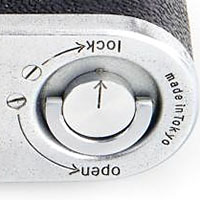
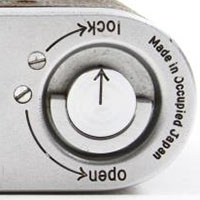

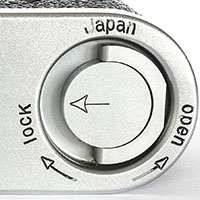
(First 3 images are details from larger web images)
Cameras sold through US Military Exchange stores (e.g. Army Post Exchange, or PX, stores) and possibly other duty free outlets were not subject to domestic Japanese tax. Starting in, some say, 1948 or 1949 but perhaps 1947 based on found Minolta 35 examples, cameras were marked with first <CPO> in English and later and more commonly with the equivalent Japanese katakana characters, <シーピーオー>. I haven't yet found any Leotax examples with the English version of the mark. The requirement seems to have ended in late 1949, but an <EP> mark was introduced for a similar purpose in 1953. For more detailed information, see <CPO> and <EP> on the Canon page:
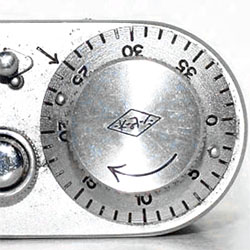 (Detail from larger web image)
(Detail from larger web image)
Although engraving errors are very rare on Japanese cameras and lenses, they are not unknown. This late K model is the only Leotax I'm aware of made by “Lotax Camera Co., Ltd.”:
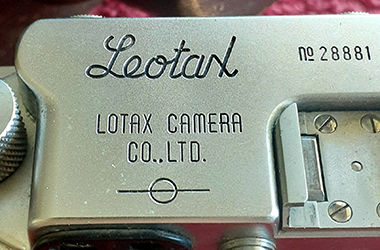 (Image courtesy of Bruce Thomas)
(Image courtesy of Bruce Thomas)
The Models
The early stamped bodies were typically defined by the evolution of the rangefinder and improving build quality. Releases were mostly linear except that sometimes there was a version with slow speeds and another without. As noted earlier, the die-cast models introduced by the Leotax F took a slightly different approach with lower priced models being based on the lead model of three different generations. I have tried to visualise that in the table below. Note also that there is a pattern to the model names and that the “V” in TV, FV and TV2 seems to indicate self-timer and that “K” is associated with no slow speeds in one case and very few slow speeds in the other (in addition to the reduced feature set of the intermediate model above it):
| Generation | Headline Feature(s) |
Models | |||
|---|---|---|---|---|---|
| 1/1,000 | 1/500 | Less Self- Timer |
Less Slow Speeds |
||
1954-58 |
die-cast | F |
T |
K (no slow speeds) |
|
1957-59 |
New viewfinder, self-timer |
TV |
T2 |
K3 (fewer speeds) |
|
1958-61 |
Lever wind, self-timer |
FV |
TV2 Merite |
T2L Elite |
|
Note 1: I haven't been able to verify the claimed generation end dates but it seems fairly certain that there was some overlap between generations by some models at least, e.g. the second and third models of a generation usually appeared a little later than the lead model so unless the previous generation lower spec models continued for a while longer, there would have been a significant gap in the range.
Note 2: The post-bankruptcy Elite S2 and G models are not shown, the G being a completely new model and the Elite S2 seems to be the TV2 Merite with a different lens offering.
Slow Speed Shutter Dial
Some sites indicate whether a model has a slow speed shutter dial lock or not. It's really simple. Models based on the early stamped body Leica III don't. Models based on the late die-cast body do (Leotax F onward). According to Japanese authority Mikio Awano, the earliest Nicca models (Nippon and Nicca Original) didn't feature click stops on the slow speed shutter dial - I don't know if that applied to any of the early Leotax models.
Note: With the shutter speeds shown below, I don't include the changeover speed shown on the slow speed dial. For example, the slow speed dial of the Leotax D IV is marked 1, 2, 4, 8, 20 and the high speed dial starts with B, 20-1, 30, 40 etc but the 1/20 shutter speed belongs to the high speed range - it is only the 1, 2, 4, 8 which use the slow speed escapement. In other words, the speeds are listed rather than the dial markings, similar but two slightly different things.
The Original Leotax
(No, the first one, not the Leotax Original, that's next)
| Typical Lens(es) Found | ||
|---|---|---|
Name |
Description |
Aperture |
| Fujita made | Collapsible |
f/3.5 |
Sugiyama tells us that about 50 cameras were made single handedly at a rate of about 10 per month by first Kanzo Nakagawa, then entrusted to Yasuo Minagawa. All parts were made in-house except for the rangefinder, made by Nihon Kosokki Kogyo, and lens, made by Fujita. The ad confirms that the lens was an f/3.5. Apparently, there are no known surviving examples (see Leotax Original below) but there is a photo taken by Yasuo Minagawa in 1939 and an ad with photo (both shown small in Sugiyama's book):
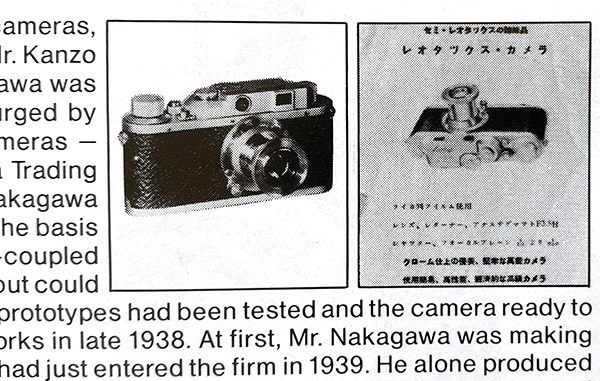
(Detail from Sugiyama's book, The Collector's Guide to Japanese Cameras, page 47)
The photos show what looks like a Leica II but with only one circular rangefinder window in more or less the usual place on camera left, looking from the front, and the typical rectangular viewfinder window a bit further to the right than normal. The focusing wheel for the uncoupled rangefinder was recessed into the viewfinder/rangefinder housing on the left behind the rangefinder window whereas on the collector named Leotax Original below, it is in the centre.
Although not stated, presumably the rangefinder and viewfinder shared a common eyepiece? If that was so, it would have been ahead of its time but perhaps the design and/or technology was not ready yet.
Leotax Original
(the other one, the second one, next one etc)
| Shutter Speeds (1/x) | |
|---|---|
Slow Speeds |
High Speeds |
| None | Z, 20, 30, 40, 60, 100, 200, 500 |
(Note, the camera below has a shutter dial marked “B”, it would probably more likely have had a dial marked with the German “Z” for “zeit” originally.)
| Typical Lens(es) Found | ||
|---|---|---|
Name |
Description |
Aperture |
| Letana Anastigmat (Fujita) | 5cm collapsible |
f/3.5 |
Kanzo Nakagawa went off to the War and Eiji Suzuki was appointed Chief Engineer in late 1940. He redesigned the camera and it is this earliest surviving version that is often, in Sugiyama's words, “mistakenly referred to as the original Leotax”, as it is on most sites and in some other references including McKeown's. Still without slow speeds and a top speed of 1/500, it looks like a typical Leica II except the uncoupled rangefinder has a focusing wheel recessed into the middle of the viewfinder/rangefinder housing and from the front, the viewfinder window is on the left with two short base rangefinder windows on the right.
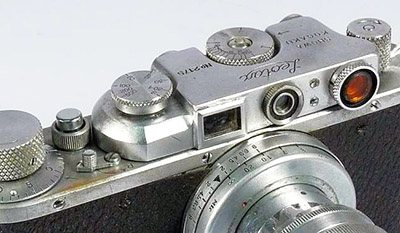 (Detail from Massimo Bertacchi's site)
(Detail from Massimo Bertacchi's site)
“Leotax” in Leica like script and maker name “Showa Kogaku” were engraved on the viewfinder housing and remained virtually unchanged until 1950. Note, the full image shows the lens fitted to the above example is a K.O.L. Xebec f/2 which originally most likely resided on a Nippon (Nicca predecessor). Also, the rangefinder window on the right features a Leica/Leica type accessory orange filter to increase rangefinder contrast.
Below are images from a Japanese research paper “The Development of the 35mm Precision Camera in Japan in the 1930s and 1940s” by Ryosuke Mori (Graduate School of Ritsumeikan University):
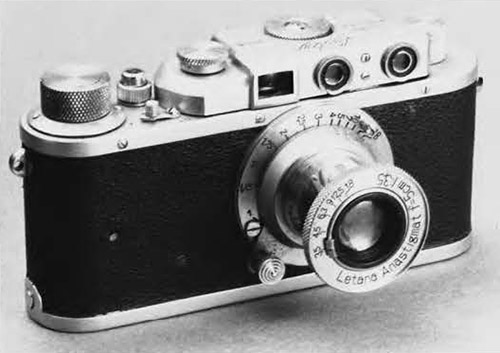
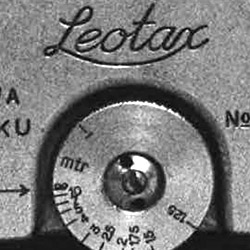
(Detail from larger images, as noted above, credited to KCM Library)
The standard lens was a “Letana Anastigmat” f/3.5 5 cm with Leitz Elmar-like collapsible body. Said by some to be made in-house by Shōwa Kōgaku, it wasn't - see Lenses Overview below, Fujita Kōgaku Kikai was the maker (Camera-wiki.org and Ryosuke Mori). Camera-wiki.org claims that the lens has 4 elements, probably because most of the lenses of this type use either the Leitz Elmar or Zeiss Tessar optical configuration. According to Ryosuke Mori, the Letana Anastigmat has been dismantled and found to be a triplet design.
| “Original” Serial Numbers | |
|---|---|
From |
To |
| 20xx | 2175 |
Leotax Special A & Special B
| Shutter Speeds (1/x) | |
|---|---|
Slow Speeds |
High Speeds |
| T, 1, 2, 4, 8 | Z, 20, 30, 40, 60, 100, 200, 500 |
(Note, the Special A does not have slow speeds)
| Typical Lens(es) Found | ||
|---|---|---|
Name |
Description |
Aperture |
| Letana Anastigmat (Fujita) | 5cm collapsible |
f/3.5 |
These two models, now with coupled rangefinders, were introduced in 1942. The Leotax Special A is Leica II based (without slow speeds) and the Special B is Leica III based (with slow speeds on a separate dial on the front of the camera), otherwise they are identical. Special B below:
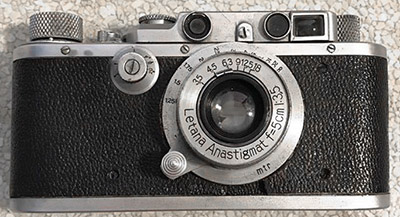
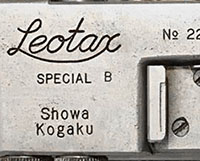
(Detail from larger web images)
Note: The Special A and other examples of the Special B feature strap lugs like earlier cameras. This Special B, marked that on top of the viewfinder/rangefinder housing, doesn't.
With continuing concerns over patents, the rangefinder on both feature a scissor strut for the sensor arm. Looking from the front, one circular rangefinder window is in its usual Leica position on the left , the second window is slightly to the right of the normal viewfinder position and the viewfinder itself is on the far right (photographer's left) hard up against the second rangefinder window. The base of the rangefinder is still short and the arrangement is less than an ideal solution.
The lens offered continued to be the Letana Anastigmat f/3.5 for most part, however the June 1947 ad below used by Mikio Awano in an article about the Leotax Special in the December 1978 Japanese magazine, Camera Collectors' News, seems to feature the Special B (strap lugs and low speed dial in pic and slow speeds quoted in text) and indicates that the lens is a “State” f/3.5 - see Leotax Special:

The ad seems too late for the Special B so it is inconclusive and confusing but it is one of the few ads from the period.
| “Special A” (no slow speeds) | |
|---|---|
| Serial Numbers | |
From |
To |
| 2096 | 247x |
| “Special B” (slow speeds) | |
|---|---|
| Serial Numbers | |
From |
To |
| 204x | 252x |
Leotax Special
| Shutter Speeds (1/x) | |
|---|---|
Slow Speeds |
High Speeds |
| None | Z, 20, 30, 40, 60, 100, 200, 500 |
| Typical Lens(es) Found | ||
|---|---|---|
Name |
Description |
Aperture |
| Letana Anastigmat (Fujita) | 5cm collapsible |
f/3.5 |
| State (Tokyo Optical) | 50mm collapsible |
f/3.5 |
The 1946 Leotax Special is basically the earlier Special A without slow speeds but also without the strap lugs that had been there from the original Leotax model (and except for the Special B example above):
 (Web image)
(Web image)
Images from Mikio Awano's article in Japanese magazine, Camera Collectors' News, December 1978:
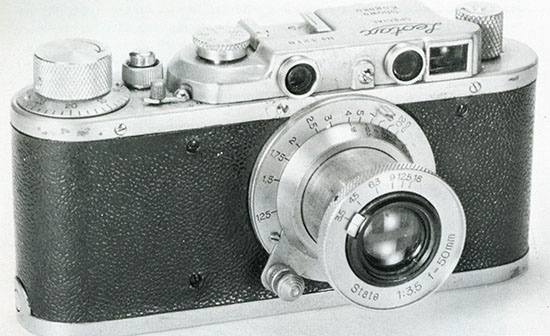
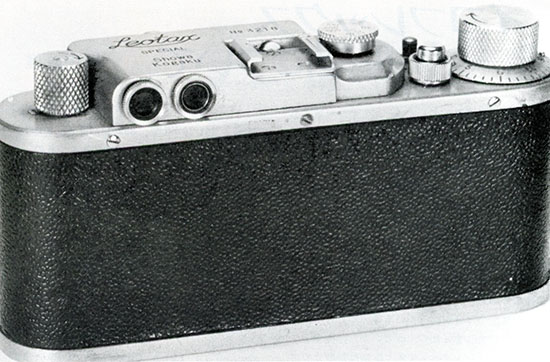
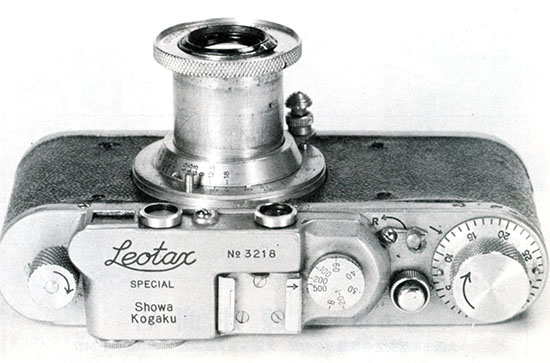
Some sources say that the lens was still the Letana, although Sugiyama displays an example with a similar f/3.5 collapsible type named “State” and the two pictured examples above also feature State lenses. The State lens was made by long term, but not exclusive, future supplier Tōkyō Kōgaku (translated as Tokyo Optical Company, later Topcon) and is similar in appearance to the following “C.Simlar” and “Simlar”. Camera-wiki.org notes that the “State” name had previously been reserved for 3 element lenses and “Simlar” for more sophisticated types, however, the Japanese Topcon Club website believes that it is a 4 elements in 3 groups Elmar design like the following versions which were merely a name change. If the Letana was indeed a three element type, as it seems, then I'm more inclined to accept the Camera-wiki explanation which makes the lens a supplier change rather than necessarily an upgrade.
| “Special” Serial Numbers | |
|---|---|
From |
To |
| 260x | 3218 |
Leotax Special D II & Special D III
| Shutter Speeds (1/x) | |
|---|---|
Slow Speeds |
High Speeds |
| T, 1, 2, 4, 8 | Z, 20, 30, 40, 60, 100, 200, 500 |
(Note, the Special D II does not have slow speeds and the late type D III substitutes “B” for “Z”)
| Typical Lens(es) Found | ||
|---|---|---|
Name |
Description |
Aperture |
| Simlar (Tokyo Optical) | 50mm collapsible |
f/3.5 |
| C.Simlar (Tokyo Optical) | 50mm collapsible |
f/3.5 |
The Special D II and D III models were released in 1947.
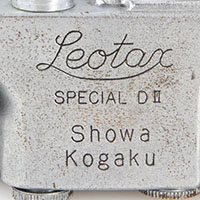
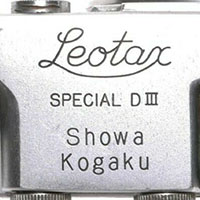 (Detail from larger web images)
(Detail from larger web images)
They were still based on the Special A without slow speeds and B with slow speeds models but the rangefinder was redesigned along conventional Leica lines. The viewfinder window is similar to the first notched Leica type. Like the Leotax Special, there are no strap lugs. Special D III:
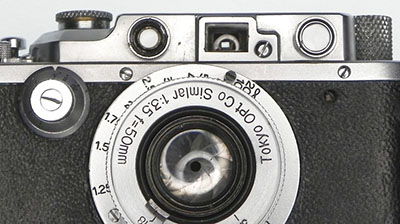 (Detail from Massimo Bertacchi's site)
(Detail from Massimo Bertacchi's site)
Although nicely finished on the exterior, earlier models had a reputation for being crudely finished inside. The Special D II and D III are said to be an improvement, although the new rangefinder construction was still considered below par.
This ad for the Leotax Special DIII and Semi Leotax appeared in the 5 September 1948 edition of Japanese magazine Camera Times:

Massimo Bertacchi's site features two late examples of the Special D III with the Leotax name engraved in heavy Serif font letters and maker name “Showa Optical Company limited” instead of the usual “Showa Kogaku” and no model name. I have found another six, the example below for sale in Japan. The eight have the highest serial numbers, so rather than a special version for some reason, they almost certainly represent a transition to adopting the Anglicised maker name before the name change to “Showa Optical Works, Ltd.” on the next model (D IV), its new “Leotax” logo style without the Leica loop under (not the same as this version) and the dropping of the model name engraving.
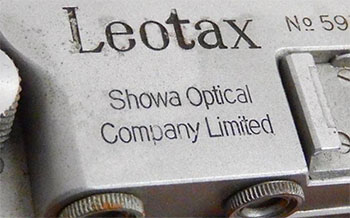 (Detail from larger web image)
(Detail from larger web image)
Note, Massimo Bertacchi refers to one of them as a military variant - it has the <CPO> mark in Japanese katakana characters on the film winding knob indicating that it was probably sold through a US military PX or NX store (see <CPO> Mark on the Canon page).
These eight are the first Leotax examples to change to “B” for bulb on the high speed shutter dial from the earlier German “Z” marking copied from Leica.
Lenses are generally claimed to be the collapsible “Simlar” f/3.5 50 mm made by Tōkyō Kōgaku (“Tokyo Opt. Co.” appearing on the lens, later Topcor lenses revert to the Japanese “Tokyo Kogaku”). The lens on the earliest Special D II in my database is still a Letana Anastigmat but the other lenses are the Simlar. Two lenses on the Special D III are also Simlars but the majority are the collapsible f/3.5 50 mm “C.Simlar” version. The “C” stands for “coated”, added when lens coating was first introduced. The State, first type Simlar and C.Simlar f/3.5 lenses feature f/18 minimum apertures with “old”, or “German”, aperture scales and are all marked “50 mm”. When the Leotax DI V was released in 1951, the “C” was dropped from C.Simlar and at the same time, the minimum aperture changed to f/16 with “modern”, or “rational”, scales and the focal length marking changed to “5 cm”.
| “Special D II” (no slow speeds) | ||
|---|---|---|
| Serial Numbers | ||
Maker Name |
From |
To |
| Showa Kogaku | 352x | 383x |
| Showa Kogaku | 501x | 503x |
| “Special D III” (slow speeds) | ||
|---|---|---|
| Serial Numbers | ||
Maker Name |
From |
To |
| Showa Kogaku | 509x | 529x |
| Showa Optical Company Limited | 557x | 593x |
NR III
| Shutter Speeds (1/x) | |
|---|---|
Slow Speeds |
High Speeds |
| None | B, 20, 30, 40, 60, 100, 200, 500 |
| Typical Lens(es) Found | ||
|---|---|---|
Name |
Description |
Aperture |
| C.Simlar (Tokyo Optical) | 50mm collapsible |
f/3.5 |
| Simlar (Tokyo Optical) | 50mm collapsible |
f/3.5 |
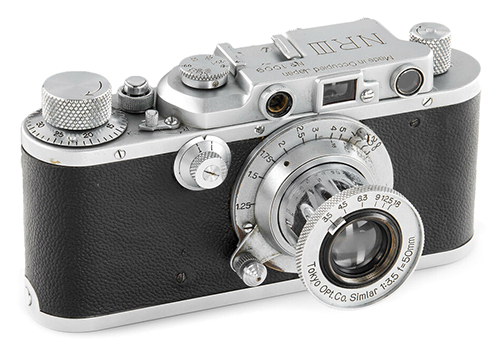
From around 1949. Same as the Special D III, except engraved “NR III” without the usual Leotax or maker name engraving. Unusually, “Made in Occupied Japan” is engraved along the front edge of the top of the viewfinder housing whereas other Leotax cameras from this period are engraved around the base plate lock:
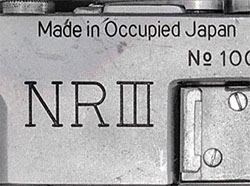 (Detail from larger web image)
(Detail from larger web image)
Produced for the US Military for news reporting during the Korean War, according to Sugiyama, less than 50 made, but serial numbers suggest maybe closer to 60 with the earliest found 1003 and an another couple below 1010 and the two highest being 1058 and 1060. Serial number 1058 belongs to the NR III on the front cover of Japanese magazine, Camera Collectors' News, January 2002.
The NR III features the “B” marking on the main shutter dial of the later type Special D III and subsequent models.
Of eight found examples, five are likely to have original lenses. The two cameras with highest serial numbers have C.Simlar 50 mm f/3.5 collapsible lenses with f/18 minimum aperture and three have the earlier uncoated Simlar versions of the same (of the other three, one is a Similar collapsible of unknown spec and one could be a later Simlar with f/16 minimum aperture).
| “NR III” Serial Numbers | |
|---|---|
From |
To |
| 1003 | 1060 |
Leotax D IV
| Shutter Speeds (1/x) | |
|---|---|
Slow Speeds |
High Speeds |
| 1, 2, 4, 8 | B, 20, 30, 40, 60, 100, 200, 500 |
| Typical Lens(es) Found | ||
|---|---|---|
Name |
Description |
Aperture |
| Simlar (Tokyo Optical) | 5cm collapsible |
f/3.5 |
| Simlar (Tokyo Optical) | 5cm |
f/1.5 |
| Zuiko (Olympus) | 4cm, + finder |
f/2.8 |
The 1950 Leotax D IV, still broadly similar to the D III with slow speeds, although dropping “T” from the dial, featured the return of strap lugs, a new rectangular viewfinder window with one curved corner (similar to the later Leica IIIa and IIIb type) and a mushroom shaped shutter button collar. The shutter button was threaded for a cable release. The D IV, its sibling Leotax S with flash sync and Leotax G are the only three models offering this convenience. The large retaining screw in the centre of the slow speed dial was replaced by a hidden arrangement. There were internal improvements too and in Camera-wiki.org's view, it was now a “sound” camera. This example owned by correspondent Gary Hill features an Olympus lens, most likely an original fitment (see below):
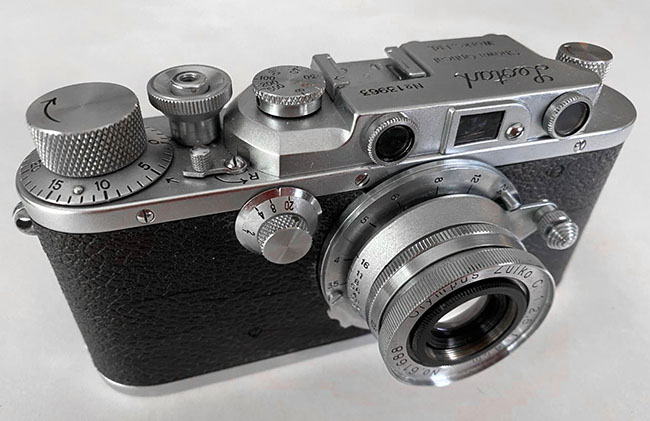
(Image courtesy of Gary Hill)
Approximately the first half of my database up to camera 1273x feature “1.5x” engraved between the eyepieces, presumably indicating the magnification of the rangefinder is now the Leica III standard of 1.5 times and suggesting that earlier models had been the Leica II standard of 1x (no longer there on 1320x, area not visible on in-between examples):
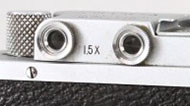 (Detail from larger web image)
(Detail from larger web image)
The “Leotax” engraving was updated and no longer featured the Leica loop under the name. The maker name was changed from “Showa Kogaku” on earlier models and “Showa Optical Company limited” on the late Special D III to “Showa Optical Works, Ltd.” There was no model name engraved:
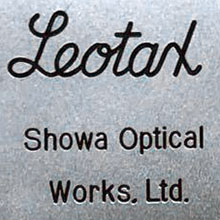 (Detail from larger web image)
(Detail from larger web image)
The lens was said to be a rigid Simlar f/1.5 5 cm but my database suggests that the collapsible f/3.5 version was still available too (also with the Leotax S), confirmed by this ad from 1951:
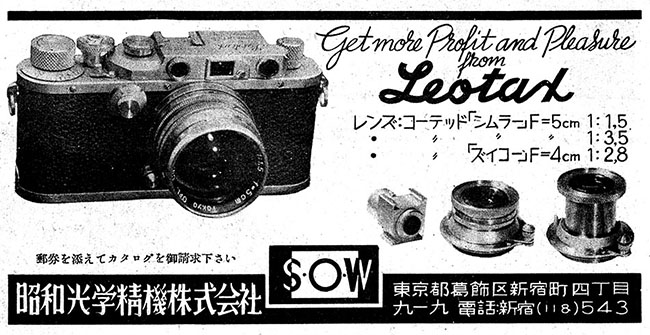
Note, the Simlar f/3.5 is now the updated version, dropping the “C” from C.Simlar, changing the minimum aperture to f/16 and the focal length marking to “5 cm”.
However, the ad displays a little surprise too! The f/1.5 is mounted and the f/3.5 is on the right at the bottom. The short lens to its left is a “Zuiko” 4 cm f/2.8. The design is 5 elements in 4 groups. To the left of it is its distinctive finder with accessory shoe on top. It is rare and the only LTM lens made by Olympus Optical Co., Ltd. More details and example on Camera-wiki.org which notes, “It is said that the lens was also advertised by Shōwa Kōgaku”. The above ad ends the speculation. It seems to be offered as an alternative standard lens rather than as an accessory wide angle lens for which role it was a bit long.
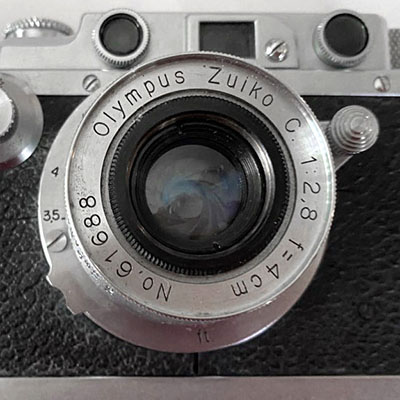 (Image courtesy of Gary Hill)
(Image courtesy of Gary Hill)
Below is a Leotax D IV with Simlar f/1.5 lens bought by correspondent Scott Sorensen's father during the Korean War. The plain shutter button and small collar are non-standard earlier items, possibly from a D II or D III. The ASA type sync posts are also a non-standard aftermarket addition with the added cover over the sync mechanism at the bottom of the shutter crate bearing the “MINICAM” trademark of Japanese flash maker Minicam Research Corporation:
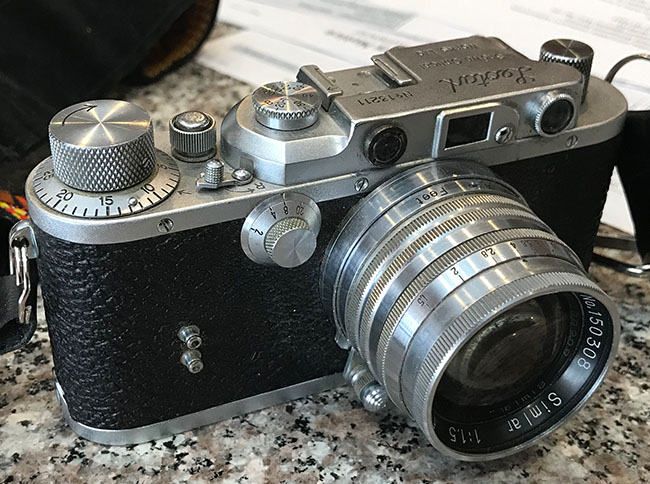
(Image Courtesy of Scott Sorensen)
The Simlar f/1.5 lens features 7 elements in 4 groups and a 12 bladed aperture. The filter ring is designed for unusually sized 40 mm filters making filter use problematic. Note, the lens was revised during its life and I'm not sure to which version, or whether to both, the specs refer. The revised lens may have had a 40.5 mm filter ring, or that may have come with the later name change to “Topcor”.
| “D IV” Serial Numbers | |
|---|---|
From |
To |
| 909x | 1497x |
Hans P. Rajner (HPR) puts the range at 12xxx to 15xxx. My corresponding found range is 1195x to 1497x but I have also come across four cameras in the 9xxx range; 909x, 913x, 918x and 928x:
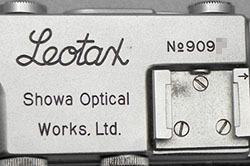
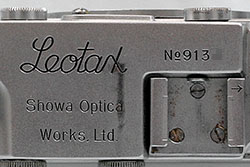
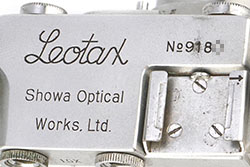
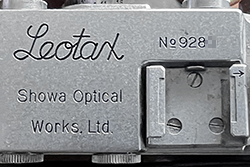
(Detail from larger web images)
Leotax S
| Shutter Speeds (1/x) | |
|---|---|
Slow Speeds |
High Speeds |
| 1, 2, 4, 8 | B, 20, 30, 40, 60, 100, 200, 500 |
| Typical Lens(es) Found | ||
|---|---|---|
Name |
Description |
Aperture |
| Simlar (Tokyo Optical) | 5cm collapsible |
f/3.5 |
| Simlar (Tokyo Optical) | 5cm |
f/1.5 |
(Note, the Olympus 4 cm Zuiko offered with the D IV was probably no longer available.)
The 1952 Leotax S is basically the same as the D IV except that it has flash sync added for the first time on a Leotax model. This example is fitted with the 5 cm f/3.5 Simlar collapsible lens with serial number 563494 suggesting it is original to the camera. The serial number is engraved near the perimeter of the black ring surrounding the front lens element. Note the filter on the table in the top view, this is a Walz 19 mm screw-in type using the same thread arrangement as the Leitz Elmar and several other copies:
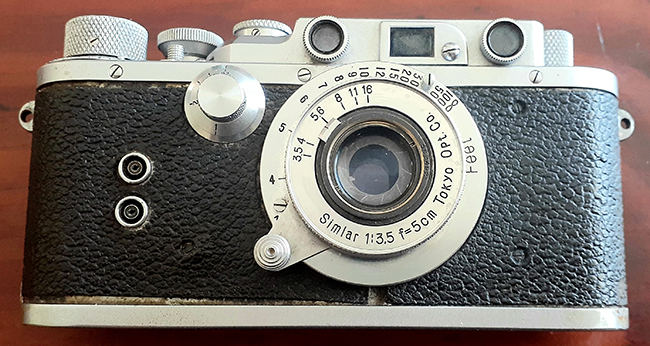
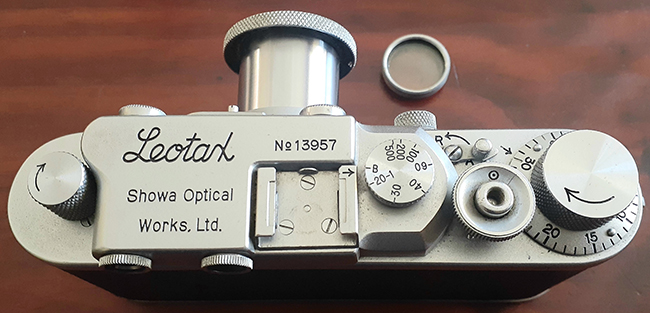
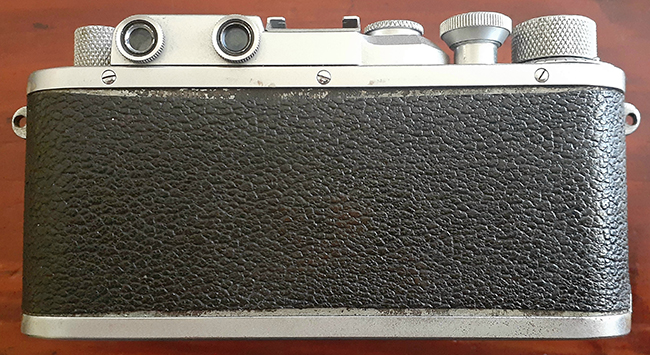
(Images courtesy of Bruce Thomas)
The front features two coaxial PC sync sockets in a similar arrangement to Nicca Type-III S to Type-4 models and like the flash synced Niccas, there is now a cover over the bottom of the shutter crate. According to Sugiyama, one socket is for FP bulbs, the other for F sync, not X sync as is usually assumed. F class bulbs are fast time to peak flash bulbs requiring a 5 milliseconds delay, i.e. the burn is set to start 5 milliseconds before the shutter is fully open. However, Sugiyama may not be completely right.
A circa 1952/3 Japanese brochure is difficult to translate accurately but it does say “flash synchroniser adopts the characteristic F (red socket) S (wire socket, maybe that should be white socket but I don't see that colour coding) circuit system (each has a time lag of 5 milliseconds and 42 milliseconds from the shutter operations...”. It goes on to list various bulbs including M and FP class. The similar vintage Nikon S may offer a clue. On the Nikon S, the two pairs of sockets (not coaxial) are marked “F” and “S”. According to the user manuals for the Nikon B.C.B. and BCB-II flashguns, “F” is the synch for “fast” shutter speeds and FP bulbs must be used and “S” is the synch for “slow” shutter speeds, i.e. when both shutter curtains are open and flash delay and duration are largely irrelevant, including for electronic flash, M class bulbs etc. Perhaps this is what Leotax meant too.
The D IV and earlier models without shutter cover looked like this. The front and rear body supports/baffles are a one piece unit screwed onto the base plate. Note, the tripod mount on this example is the larger European type 3/8" favoured by Leica (can be adapted to 1/4" with a screw in bush):


 (Details from larger web images)
(Details from larger web images)
The Leotax S introduced a shutter cover to protect the sync mechanism. This would have interfered with the previous frame across the base plate so the S base plate features a rear body support only which is secured without visible fasteners (the front was restored on the die-cast models). The tripod mount has changed to the more common 1/4":


 (Details from larger web images)
(Details from larger web images)
The ad below tells us it has a synchroniser, but without any sync details mentioned, and the only lens listed is the Simlar f/1.5 (mounted).
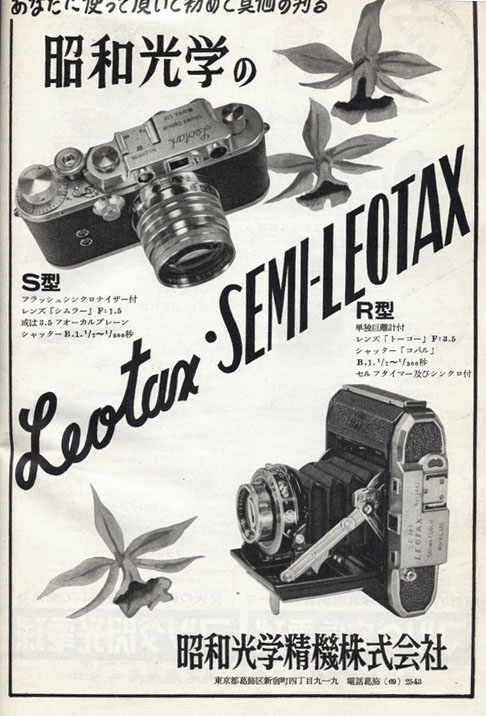
(Asahi Camera ad, 1954)
The six earliest cameras in my database have lower serial numbers than the others, as if they are part of the late D IV serial numbers range, but they have the factory sockets and shutter cover plates of other S examples. Camera No. 13957 pictured above is the second earliest of these.
| “S” Serial Numbers | |
|---|---|
From |
To |
| 1305x | 1489x |
| 2800x | 3079x |
Leotax F
(Note: From this point forward, there was typically a major model release followed by several variations with features deleted and/or specs downgraded to provide lower price points)
| Shutter Speeds (1/x) | |
|---|---|
Slow Speeds |
High Speeds |
| T, 1, 2, 5, 10, 15 | B, 25, 35, 50, 75, 100, 200, 500, 1000 |
| Typical Lens(es) Found | ||
|---|---|---|
Name |
Description |
Aperture |
| Simlar (Tokyo Optical) | 5cm collapsible |
f/3.5 |
| Simlar (Tokyo Optical) | 5cm |
f/1.5 |
| Topcor | 5cm collapsible (Elmar) |
f/3.5 |
| Topcor | 5cm collapsible (Tessar) |
f/3.5 |
| Hexanon | 50mm |
f/1.9 |
| Topcor | 5cm |
f/2 |
| Topcor | 5cm |
f/1.5 |
| Topcor-S | 5cm chrome |
f/2 |
| Zunow | 5cm “sold with Leotax” |
f/1.3 |
| Zunow | 5cm “sold with Leotax” |
f/1.1 |
(The Zunow lenses are claimed to have been sold by Zunow as a package deal with a Leotax body, details under “F” Serial Numbers below.)
A new chapter in the company's progress was ushered in by the 1954 Leotax F. This completely new model featured a die-cast body and new one piece top plate and viewfinder housing extending to the sides of the lens mount. Like similar models that would arrive from Nicca, it looked like the Leica IIIc/IIIf which inspired it and the single PC sync socket was on the back similar to the Leica IIIf. There is a fair chance that the model name is a nod to the IIIf:
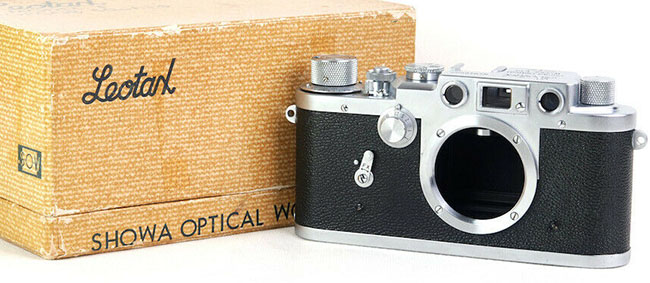
(Detail from larger web image)
The film winding knob now has a film speed reminder on top and this featured two changes during the model's life (see further below). The above box belongs to a camera with the first type, the box below to a camera with the second type but when supplied with an f/1.9 Hexanon, the box changed to a solid yellow (see further below):
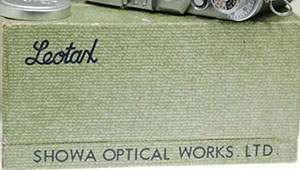 (Detail from larger web image)
(Detail from larger web image)
The example below belongs to correspondent Bruce Thomas and is the earliest that I have seen so far. The collapsible 5cm f/3.5 Simlar was still the typical entry level lens at this stage:
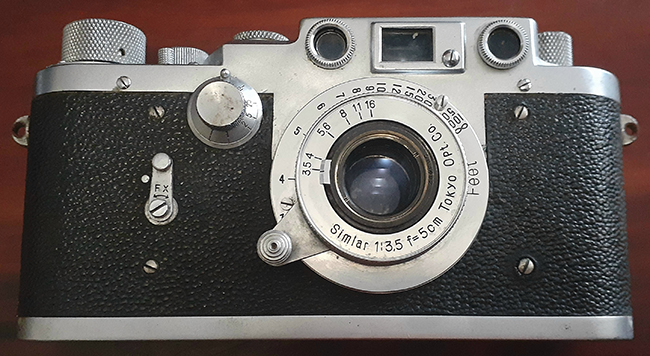
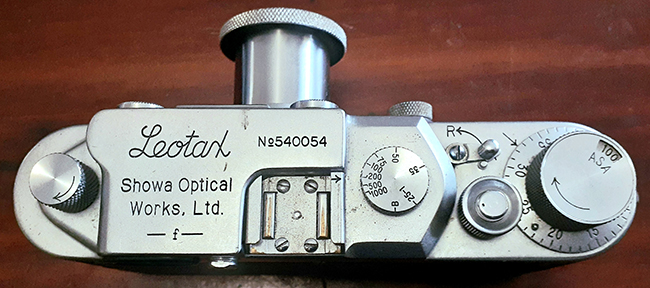
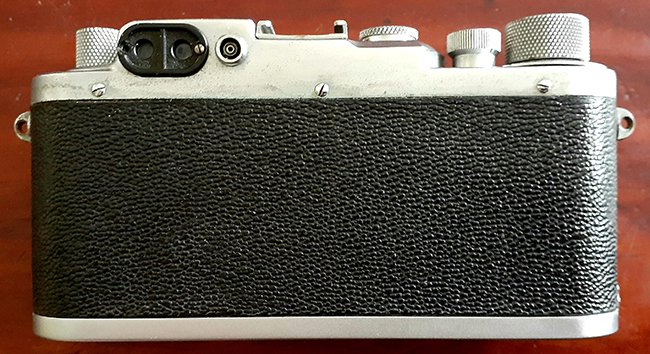
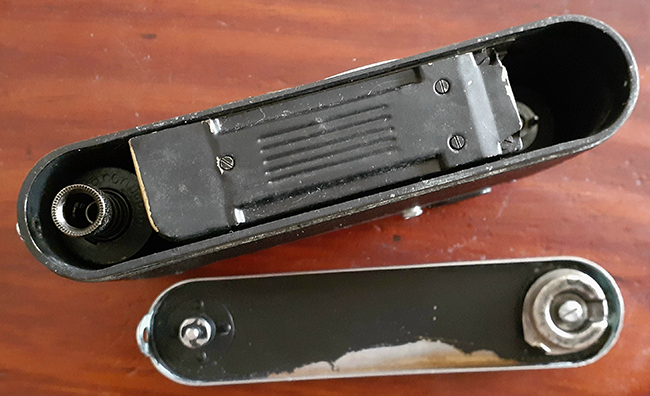
(Images courtesy of Bruce Thomas)
Like the Leica IIIc/IIIf models, the slow speed dial on the front now features a lock for the first time and the previous changeover speed of 1/20 has been increased to 1/25 (the changeover speed is now in the centre position of the slow speed dial). The speeds have been revised and the “T” setting restored. This is the first Leotax model with a top speed of 1/1000.
X sync is also at 1/25. There is a lever on the front that looks like a miniature self-timer marked “F” and “X”. “F” is for FP sync using FP bulbs and “X” is for using electronic flash. The flash socket is on the back of the top plate just to the right of the viewfinder eyepiece (see photos of Leotax K a little further below).
The previous plain accessory shoe secured by 3 screws has been replaced with the spring loaded type with 4 screws.
For the first time, there is a film plane mark but rather than the usual circle over a line symbol “O” used with the mark, the F uses something which looks like a cross between a lower case “f” and a pounds sterling sign “£”. It may mean “film”. Massimo Bertacchi thinks that it is used to denote “F” model, but it is also used on the T, TV, K3 and FV whereas the other new models use “O” (see below).
Another noteworthy change was the base plate locking mechanism from the earlier Leica-like type on the left to the new version on the right:

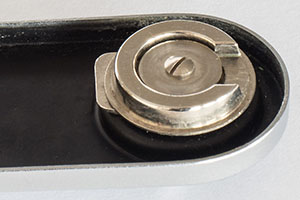
(Left detail from larger web image)
The practical result of this was that the Leica-like reloadable film cassettes that had been suitable for models up to and including the Leotax S, will not work with the Leotax F and later models. These use a new type based on the Zeiss Contax design - see Reloadable Film Cassettes.
This earlyish model F system brochure in English includes accessory lenses, filters and lens hoods and tells us that the available standard lenses are the Topcor f/1.5 and f/3.5 but over the life of the model, the selection seems to have been broader than that:
.jpg) (Scan provided courtesy of Gary Hill)
(Scan provided courtesy of Gary Hill)
(Click on cover for PDF of full brochure)
There are seven early examples in my database fitted with the Simlar f/3.5 collapsible lens and the Japanese Topcon Club website tells us that the initial 1954 lens choice for the Leotax F was this lens and the redesigned Simlar f/1.5. These were replaced in 1955 by the same lenses with the new Topcor name but at some point, the original f/1.5's 40 mm filter ring changed to the more common 40.5 mm. In 1956, the f/3.5 lens was redesigned from Elmar to Tessar type with a full size aperture ring instead of the tab at the front and the chrome Topcor f/2 5 cm lens, with 6 elements in 5 groups, was added to the range. It was replaced in 1957 by a similar in appearance Topcor-S but with a revised 6 elements in 4 groups construction (a cemented doublet replaced an air gapped pair in the rear groups). The Topcor features an amber coating and the Topcor-S, magenta. Both feature 40.5 mm filter rings:
Topcor 5 cm f/2 on left and Topcor-S f/2 on right (side by side, the Topcor-S stands taller):
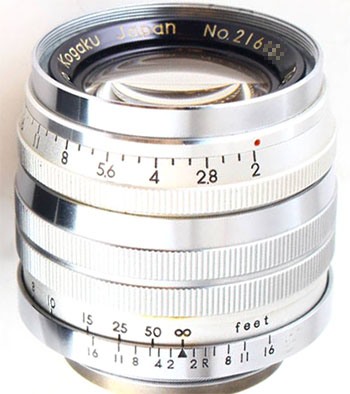
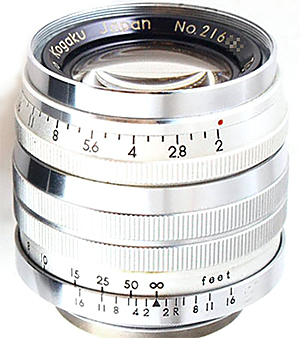
(Web images)
The Asahi Camera 1955 ad below prices the Leotax F at ¥65,000 yen with the Topcor f/1.5 5 cm and ¥38,500 with the Topcor f/3.5 5cmm. The f/2 is not mentioned so the ad may have been from before it arrived but a 1956 ad lists it as ¥48,500 (see Leotax T). However, it seems that the hole in the range caused by the absence of a Topcor f/2 may have been filled by the Hexanon f/1.9 5cm (more on this lens in Leotax T). Mid-production camera 5514x was originally supplied with the Hexanon confirmed by its box and “Inspected Card” with matching serial numbers (unfortunately the images are low resolution):
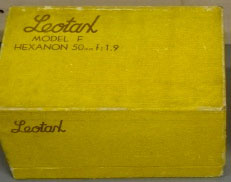
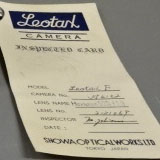 (Detail from larger web images)
(Detail from larger web images)
Further evidence is found in the US Department of Commerce booklet, The Development of the Japanese Photographic Products Industry, 1954-1958, which lists the 1957 Japanese retail price of the Leotax F with both Topcor f/2 and Hexanon f/1.9 (same price, both more than the 1956 ad referred to above). One Leotax F has been found with the Hexar f/3.5 collapsible lens but so far, there is no evidence confirming that it was offered on this model. I have also just bought a Japanese brochure (not by Showa Optical Works, maybe a distributor) which advertises the F with a Hexanon and the T with the f/3.5 Hexar.
For models then current (F, T and K), when the maker name engraving changed from “Showa Optical Works, Ltd.” to “Leotax Camera Co., Ltd.” in 1956, the new film speed reminder on top of the film winding changed from featuring segments in black, white & red (shown BWR in the tables) to a generally white background with parts of the scales shown white on a narrow black band (shown B&W in the tables). However, for the Leotax F, it was even more complicated. When first released, the film speed reminder was actually a window in the top of the dial. This looks like the reminder found on the later generation Leotax TV, T2 and K3 series except that on the earlier F, the knob is two piece with the top disc separate to the cylindrical knurled grip which lifts up to effect changes, on the later series, it is one piece. There are 16 such model Fs in my database with serial numbers 540054 to 54600x. Then there are thirty with the BWR reminders with serial numbers 54582x to 55615x. Next is the change in name to to “Leotax Camera Co., Ltd.” with serial number 25000x being the first and 26113x being the highest (about 50% of the F examples in my database). These have the black and white (B&W) dials.
Image 1 features the earlier maker name and film speed reminder window. Image 2 features the earlier maker name type with the BWR film reminder. Image 3 features the later name and B&W reminder:
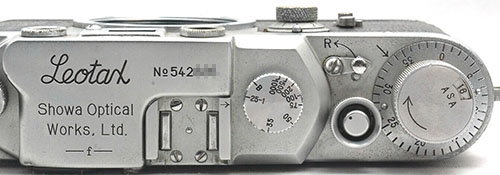


(Detail from larger web images)
An early Japanese ad for the Leotax F with first type film speed reminder and like the brochure above, no mention yet of f/2 lens options:
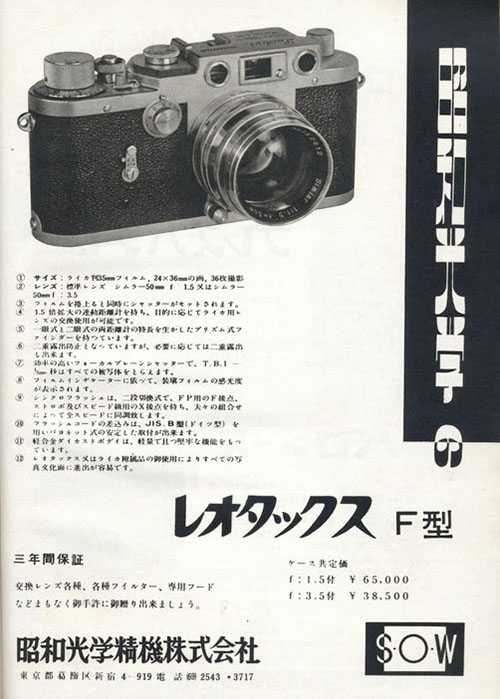
(Asahi Camera ad, 1955)
| “F” Serial Numbers | |||
|---|---|---|---|
Maker Name |
From |
To |
Film Speed Reminder |
| Showa Optical Works, Ltd. | 540054 | 54600x | Window |
| Showa Optical Works, Ltd. | 54582x | 55615x | BWR |
| Leotax Camera Co., Ltd | 25028x | None |
|
| Leotax Camera Co., Ltd | 25000x | 26113x | B&W |
The Topcon Club website tells an interesting story about the Leotax F and Zunow. Zunow was a small lens maker famous for releasing the first f/1.1 lens thereby starting the 1950's aperture wars. Translated (slightly cleaned up), this is the claim: “In addition to these lenses (the usually supplied lenses), Zunow 5cm f1.1 and f1.3 were sold with Leotax F, but actually, Zunow ordered the body from Leotax and it (the camera and lens) was released from Zunow. Because it was a game, it was published in the form of "(lens) with Leotax" in the catalogue at that time. In terms of price, the Topcor 5 cm f 1.5, Zunow 5 cm f 1.3, NIKKOR 5 cm f 1.4, etc. were in the same range, and were very expensive at that time.”
If correct, this Leotax F with Zunow f/1.3 lens may be one of those originally sold by Zunow:
 (Detail from larger web image)
(Detail from larger web image)
Leotax T (Leotax F based)
| Shutter Speeds (1/x) | |
|---|---|
Slow Speeds |
High Speeds |
| T, 1, 2, 5, 10, 15 | B, 25, 35, 50, 75, 100, 200, 500 |
| Typical Lens(es) Found | ||
|---|---|---|
Name |
Description |
Aperture |
| Topcor | 5cm collapsible (Elmar) |
f/3.5 |
| Topcor | 5cm collapsible (Tessar) |
f/3.5 |
| Topcor | 5cm |
f/2 |
| Topcor | 5cm |
f/1.5 |
| Topcor-S | 5cm chrome |
f/2 |
| Hexar | 50mm collapsible |
f/3.5 |
| Hexanon | 50mm |
f/1.9 |
| Fujinon | 5cm |
f/2.8 |
| Fujinon | 5cm |
f/2 |
Released in 1955, this is a budget version of the F with the 1/1000 speed removed (i.e., top speed is 1/500). Otherwise it is the same.
The first example (25017x) engraved “Leotax Camera Co., Ltd.”, which ushers in the new serial number range, still features the earlier black, white and red film type reminder before changing to the black and white type.
Earlier cameras are more likely found with the Topcor f/3.5 collapsible lenses but the majority feature the similar spec and appearance Hexar f/3.5. There are also six Leotax T examples in my database with Hexanon f/1.9 50 mm lenses. I am aware of claims being made and disputed about Konishiroku (the later Konica) lenses being offered by Leotax but they are listed in the Leotax T user manual and in the brochure for the Leotax F and T mentioned earlier. Below is documented proof for the Hexanon f/1.9 lens. Pictured is the camera's “Inspected Card” glued to a timber presentation box and the mounted lens itself. I doubt the box's authenticity, there is no precedent for anything like it and I doubt that the camera with lens mounted would fit in its original ever-ready case and there would need to be plenty of padding. However, I am absolutely certain that the “Inspected Card” is genuine - its style and stamps match the others I have seen, several of which there are low resolution examples on this site (including one in this section further down), and serial numbers of the camera's body and lens match the card:
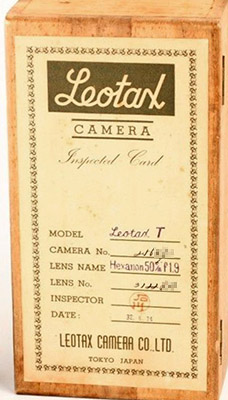
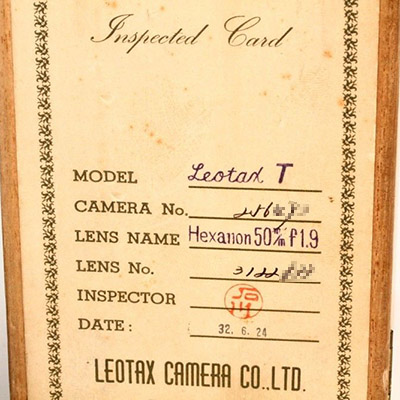

(Detail from larger web images)
The date is in the Japanese Showa era format and translates to 24 June 1957.
I noted above that there is excellent evidence that the Leotax F was offered with both the Topcor f/2 and the Hexanon f/1.9. The same source, the US Department of Commerce, provides a price for the Leotax T with f/3.5 Hexar, as does this Leotax ad:
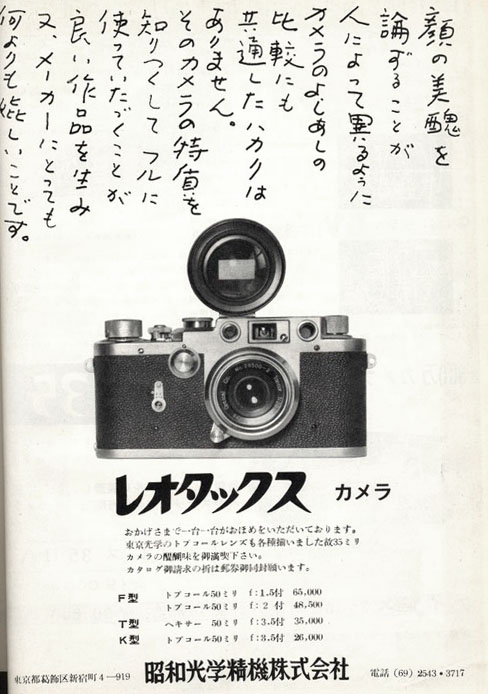
(Asahi Camera ad, 1956)
The Japanese Topcon Club website claims that both the Topcor and Hexar collapsible f/3.5 5 cm lenses were indeed offered but doesn't mention the f/1.9 model. On the other hand, Camera-wiki.org confirms that both were offered and notes the Elmar inspiration of the Hexar appearance and “Tessar-like formula” of 4 elements in 3 groups (the diaphragm is behind the second element, typical of Tessar rather than Elmar formula). The aperture is 10 bladed, filter details further below. The Hexanon features 6 elements in 5 groups, 10 bladed aperture and 40.5 mm filter diameter.
On the left below is the earlier Elmar based Topcor f/3.5 5 cm lens (collapsed) from my database, Sugiyama also displays a Leotax T with one fitted. In the middle is the later Tessar type Topcor f/3.5 with new full size aperture ring and serial number on the front. On the right is the Hexar f/3.5 that looks very much like the middle Topcor:
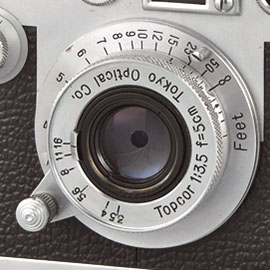
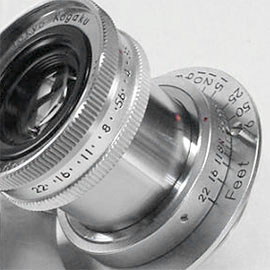
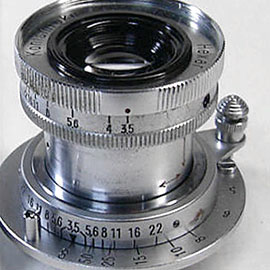
(Detail from larger web images)
Unlike the earlier Topcor, the latter two also have a filter threads as well as accepting 36 mm slip-on filters and hoods. The Hexar takes 34.5 mm screw in filters (Camera-wiki.org) but I suspect that the Topcor is the slightly more common 34 mm (slightly thicker appearing bezel and it may be a common Topcor size for the f/3.5 versions and the f/2.8). The Hexar also has an inner 19mm filter thread like the Leitz Elmar (the Hexar here is mounted on a Minolta 35):
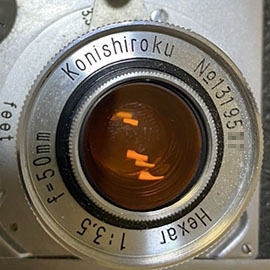 (Detail from larger web image)
(Detail from larger web image)
The Japanese Topcon Club notes the arrival of both the Topcor f/2 and redesigned f/3.5 to the Leotax T in 1956. I have yet to find any T with the either the Topcor f/2 or f/1.5 but both are listed in the user manual. One example has also been found with a chrome Topcor-S f/2 and “Inspected Card” with matching serial numbers:
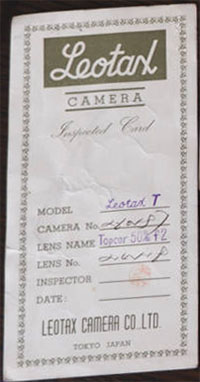 (Detail from larger web image)
(Detail from larger web image)
There is also a warranty card with matching numbers and the date “33.2.5” which translates to 1958, February 5.
As five late cameras, three of which are adjacent in my database, have been found with Fujinon f/2 5 cm lenses and one with a Fujinon f/2.8 version and both apertures start appearing from here on in, I assume that these are likely original fitments. Their serial numbers are at the beginning of Fujinon lenses found mounted on Leotaxes and therefore look completely appropriate. Unlike the Konishiroku lenses, they are not mentioned in the Leotax T user manual.
| “T” Serial Numbers | |||
|---|---|---|---|
Maker Name |
From |
To |
Film Speed Reminder |
| Showa Optical Works, Ltd. | 54485x | 55641x | BWR |
| Leotax Camera Co., Ltd | 25017x | BWR |
|
| Leotax Camera Co., Ltd | 25169x | 26168x | B&W |
Leotax K (Leotax F based)
| Shutter Speeds (1/x) | |
|---|---|
Slow Speeds |
High Speeds |
| None | B, 25, 35, 50, 75, 100, 200, 500 |
| Typical Lens(es) Found | ||
|---|---|---|
Name |
Description |
Aperture |
| Topcor (no. on front) | 5cm rigid (Elmar) |
f/3.5 |
| Topcor (no. under) | 5cm rigid (Tessar) |
f/3.5 |
| Fujinon | 5cm |
f/2.8 |
| Fujinon | 5cm |
f/2 |
(Note, whilst there are 16 Leotax K examples found, or recorded, with Fujinon lenses in my database, the majority by far feature one of the rigid f/3.5 Topcors, about half and half, the ones with serial numbers on front first).
Also released in 1955, it is the budget version of the budget Leotax T and removes the slow speeds of both the F and T. Or, think of it as an F with a top speed of 1/500 and no slow speeds. Basically all three cameras are the same except for those two features.
My Leotax K featured below. The lens is a matching late type with the serial number in the ball park for the camera but the lens was bought separately and is not original to the camera. It was probably retailed with a Fujinon f/2.8 (see further below).
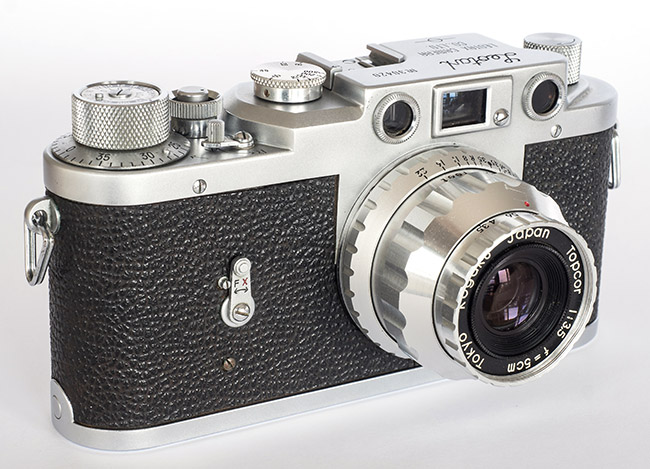
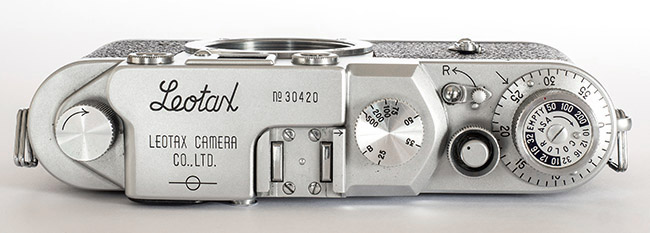
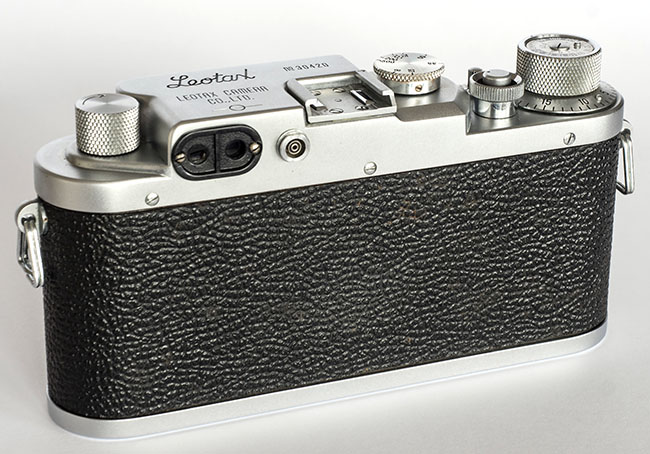
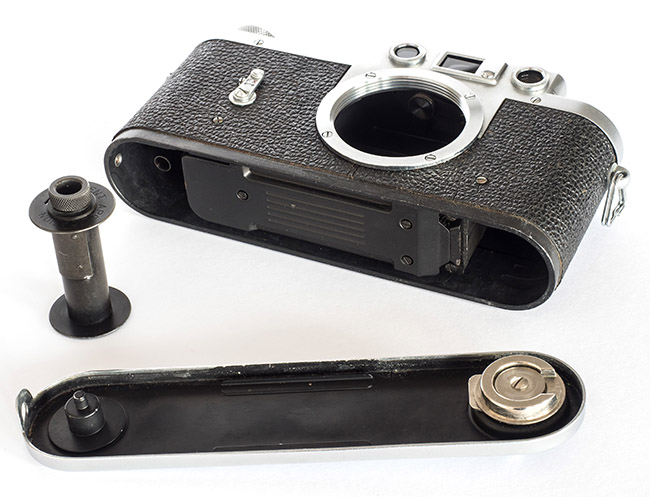
Correspondent Bruce Thomas has sent photos of his Leotax K with misengraved maker name, “Lotax Camera Co., Ltd.”. Such errors are very rare but not unknown, particularly with Japanese lenses, however, this is the only Leotax example that I am aware of:
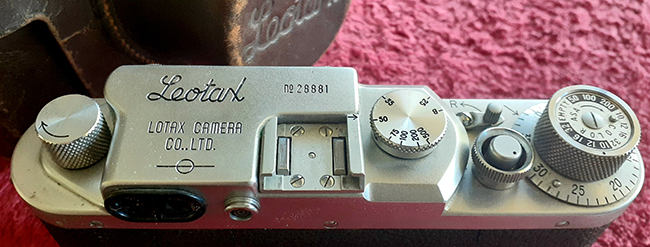
(Image courtesy of Bruce Thomas)
Lens-wise, the Leotax K seems relatively straightforward, it is mainly found with a rigid aluminium Topcor f/3.5 5 cm lens that is claimed to have been developed for this model alone. It doesn't tend to get found on other models so that is probably correct.
According to the Japanese Topcon Club website, there were two versions, the earlier one being based on the Elmar type collapsible Topcor and the later 1956 version based on the redesigned Tessar type collapsible. There is no guide on how to tell them apart physically but here is what I do know. Lenses fitted to earlier cameras have serial numbers ranging from 580xxx to 584xxx and the numbers are located on the front make-up ring. Lenses fitted to later cameras typically range from serial number 584xxx to 589xxx and these are located underneath the lens towards the mount. Note that whilst the serial numbers are usually 6 digit, two random examples of the later type have 7 digit numbers, 588298x and 588856x. The changeover between early and late types occurred around camera 5973x. Presumably, they are the Elmar and Tessar types respectively. The filter size is 34 mm with a 36 mm lens cap. On the earlier type, there is both the outer 34 mm mount and a 27 mm inner one for smaller filters. Early type immediately below, two photos of later version below that:
 (Detail from larger web image)
(Detail from larger web image)
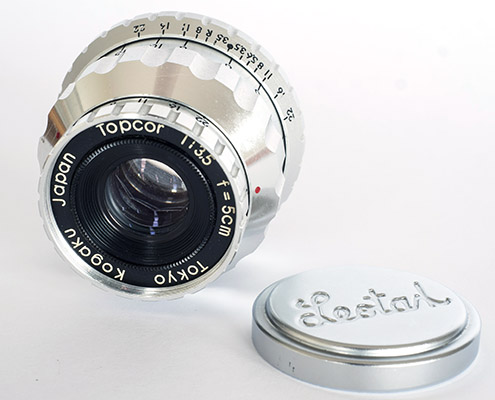
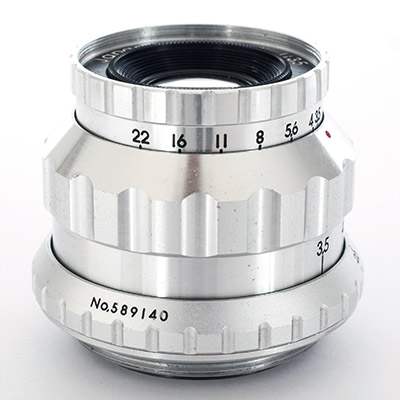
However, the last 12 Leotax K examples in my database found with lenses, serial numbers 2783x to 3075x, are fitted with Fujinon f/2.8 5 cm lenses as well as two slightly earlier ones (2582x and 2589x) and another with the f/2 version (2649x) - I don't know whether the f/2 is an original option or not but the f/2.8 lenses certainly are. One boxed example was found with its “Inspected Card”, like the Leotax T with Hexanon above, which confirms that its lens is an original fitment. Age-wise, the serial numbers of all except one, but including the f/2, appear to be appropriate to the cameras. My camera above is one of the eight but its Fujinon was removed at least one sale before I bought it, an earlier photo, which I stumbled on by chance, showing lens mounted with filter on the front:
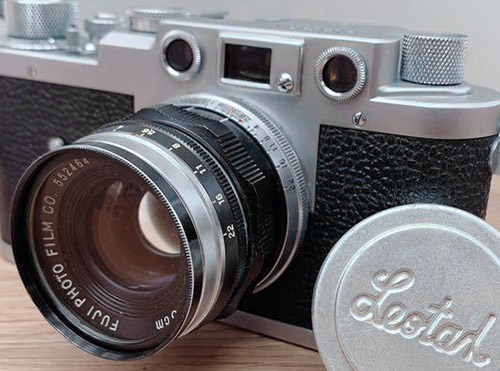 (Detail from seller photo)
(Detail from seller photo)
Below is correspondent Bruce Thomas' (see “Lotax” above) other Leotax K, this one found with a Fujinon f/2.8 lens. The lens serial number seems a little high for a K model but the body fits in the serial number range for it to be original:
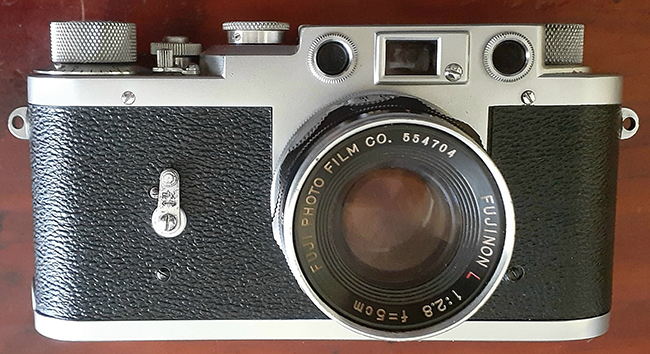
(Image courtesy of Bruce Thomas)
Another Leotax K camera in my database (not included in the 12 plus 3 above) is without lens but was found with box and its “Inspected Card”, with body number on the card matching the camera and the lens again recorded as a Fujinon f/2.8:
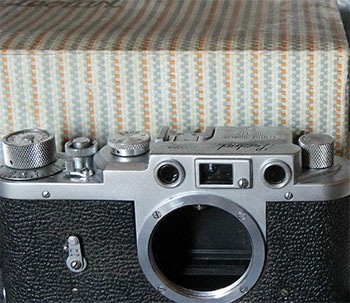
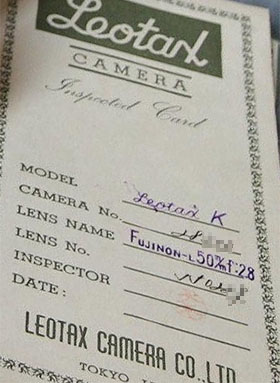
(Detail from larger web images)
Fujinon lenses seem to have been offered on the later models T2 and K3 but these K and late T examples from a similar period make their appearance earlier and the Leotax TV2 user manual extends it later.
| “K” Serial Numbers | |||
|---|---|---|---|
Maker Name |
From |
To |
Film Speed Reminder |
| Showa Optical Works, Ltd. | 5523x | 5552x | Window |
| Showa Optical Works, Ltd. | 5534x | 6154x | BWR |
| Leotax Camera Co., Ltd | 2517x | 2534x | BWR |
| Leotax Camera Co., Ltd | 2511x | 3075x | B&W |
Note: There was a short transition period for the change from the BWR to the B&W film type reminder, 3 cameras found so far.
Leotax TV
| Shutter Speeds (1/x) | |
|---|---|
Slow Speeds |
High Speeds |
| T, 1, 2, 4, 8, 15 | B, 30, 60, 125, 250, 500 |
| Typical Lens(es) Found | ||
|---|---|---|
Name |
Description |
Aperture |
| Topcor-S | 5cm chrome |
f/2 |
| Topcor-S | 5cm panda |
f/2 |
The 1957 Leotax TV was the first of an updated generation:
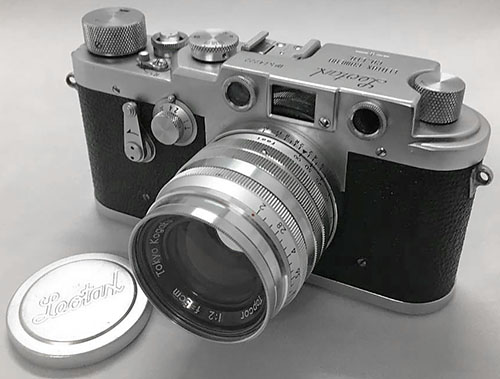 (Photo by a previous seller of my Leotax TV with matching chrome Topcor-S f/2 lens - by my purchase, the lens had been removed)
(Photo by a previous seller of my Leotax TV with matching chrome Topcor-S f/2 lens - by my purchase, the lens had been removed)
The headline news is the fitting of a self-timer and removal of the flash sync switch. Contrary to claims by some commentators, rather than being limited to X sync, the ad below tells us that the socket is automatically switching between FP and X like Nicca (see also Flash Sync below):
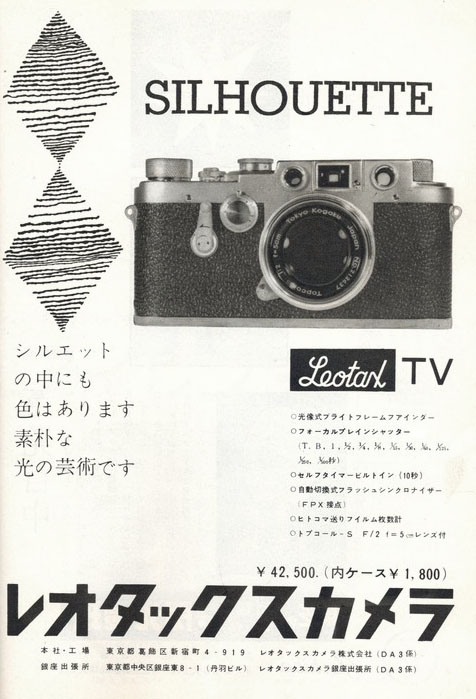
(Asahi Camera ad, 1958)
By the way, the significance of the “Silhouette” reference escapes me but is it English, or French? More in Leotax TV2 Merite.
For the first time, the viewfinder-rangefinder housing makes a departure from the Barnack Leica shape and wraps around the back of the rewind lever like the Leica M3. More importantly, there is a bigger viewfinder, noticeable from the front and given away by the new rectangular eyepiece on the rear:
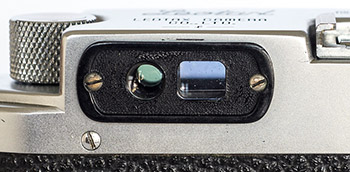
There is a reflected bright line frame for the 50 mm normal lens (not visible in the photo) and a small area outside this to provide a more expansive view, useful for using a wide angle 35 mm lens without the accessory finder (see Viewfinder and Rangefinder die-cast Models):
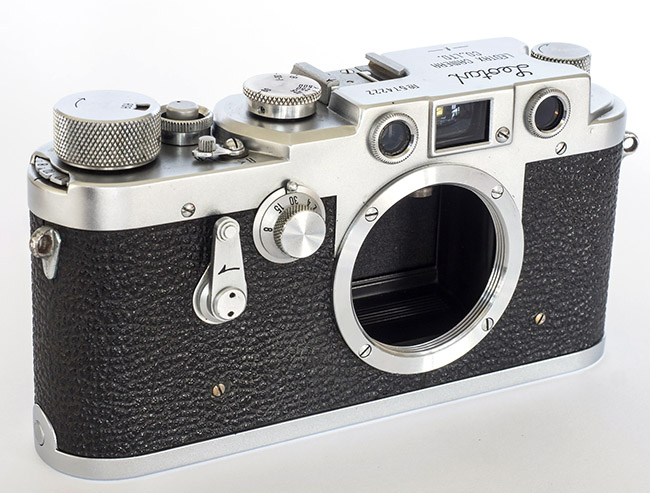
The flash sync socket on the back has been moved slightly right to sit under the accessory shoe and the central top plate retaining screw omitted:

On the other side, equally radically but perhaps not as usefully, the frame counter moves from the Leica position of directly under the film winding knob to under the top plate under the film winding knob with the edge exposed for reading and setting of the serrated wheel:
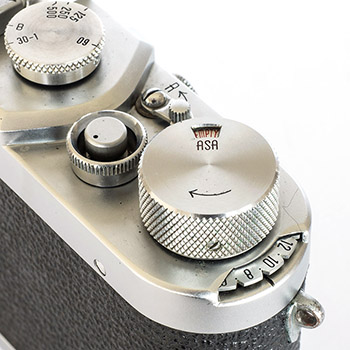
In place of the earlier dial type film speed reminder, the film winding knob appears solid again and the film speed is now visible in a window towards the edge of the knob. The one piece outer cover lifts up and rotates to change the setting.
Whilst the overall height to the top of the viewfinder housing remains the same as the previous generation, the slightly larger front viewfinder window, higher left shoulder (viewed from the front) to incorporate the enclosed frame counter dial and the addition of the self-timer introduce a vaguely Leica IIIg like appearance to go along with the M3-like viewfinder/rangefinder cover.
The shutter adopts the modern geometric speed progression and accordingly, the changeover and X sync speed increases slightly from 1/25 to 1/30. Top speed remains the 1/500 of the previous T and K.
The lens listed in the above ad is the f/2 5 cm Topcor-S. The Leotax TV is most commonly found with the earlier chrome version but the later black and chrome panda version arrived in 1958:
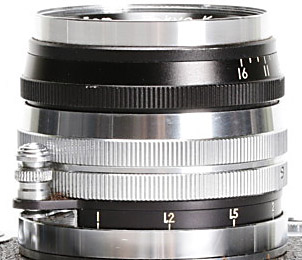

(Detail from larger web images)
Boxed TV with panda lens (filter fitted):
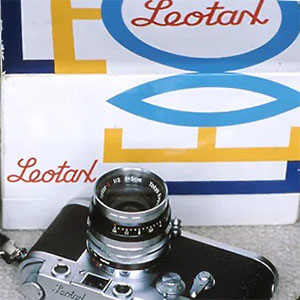 (Detail from larger web images)
(Detail from larger web images)
| “TV” Serial Numbers | |
|---|---|
From |
To |
| 57009x | 57767x |
Leotax T2 (Leotax TV based)
| Shutter Speeds (1/x) | |
|---|---|
Slow Speeds |
High Speeds |
| 1, 2, 4, 8, 15 | B, 30, 60, 125, 250, 500 |
| Typical Lens(es) Found | ||
|---|---|---|
Name |
Description |
Aperture |
| Fujinon | 5cm |
f/2.8 |
| Fujinon | 5cm |
f/2 |
| Topcor | 5cm |
f/2.8 |
Released in 1958, this is a cheaper version of the TV with the self-timer and the “T” setting on the slow speed shutter dial removed.
 (Detail from larger web image)
(Detail from larger web image)
Sugiyama tells us that the standard lens is the Fujinon f/2 5 cm but whilst seventeen T2 examples in my database have the Fujinon f/2 lens, six are fitted with Fujinon f/2.8 lenses. In line with what I have found, the Japanese Topcon Club website affirms that both the f/2 and f/2.8 Fujinon were offered. Fujinon f/2, see K3 below for similar bodied f/2.8:
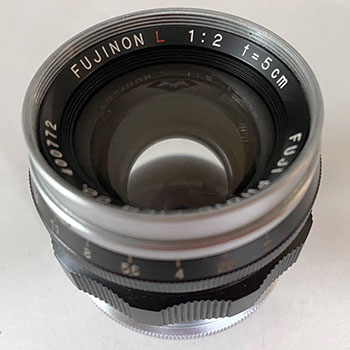 (Image courtesy of Gary Hill)
(Image courtesy of Gary Hill)
The two Fujinons featured 10 aperture blades, the f/2.8 a 5 elements design and 40.5 mm filter thread and the f/2 a 6 elements in 5 groups design with 43 mm filter thread.
The Japanese Topcon Club website further claims that the T2 was also available with the little known f/2.8 5 cm Topcor - it is not suggested by anyone for any other model but of the ten in my database found with a camera, two were with a T2, three with the sibling K3 and one with the lead model for this generation, the TV. Surprisingly, whilst one is found with the previous generation lead model F, there are three mounted on the model below that, the T. They have appropriately low serial numbers.
The Topcor f/2.8 is a 5 elements in 3 groups design and features an unusual hood design with a one touch conversion to lens cap. The base of the hood is marked “34 mm A”, presumably the filter thread diameter. The right image shows the hood in the stowed position:
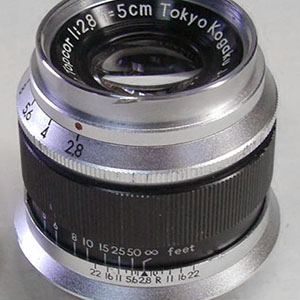
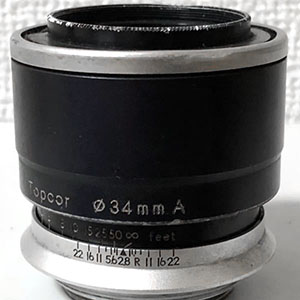
(Detail from larger web images)
Two views with hood extended:
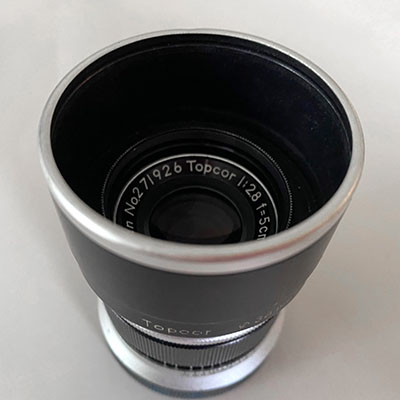
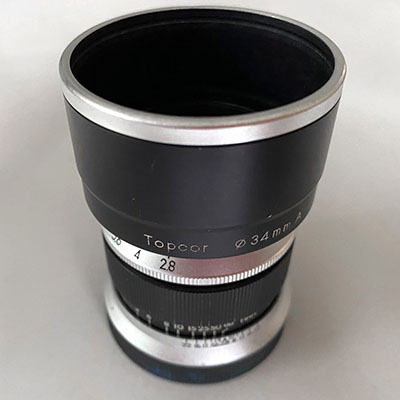
(Images courtesy of Gary Hill)
Below is the front of a damaged T2 box and next to it, detail from one end (repaired with tape) displaying a T2 label advising that the body in this case was supplied with the Fujinon f/2:
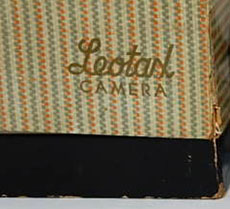
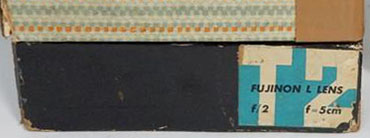 (Detail from larger web images)
(Detail from larger web images)
There is a second camera with the same box. The boxes are unusual because they are the same design as the earlier F/T/K generation whereas I have found both the T2's siblings, the TV and K3 with a new generation box, see those models. Both boxed T2 examples have lowish serial numbers so it is possible that the updated TV/K3 look was introduced later (maybe for those cameras too).
| “T2” Serial Numbers | |
|---|---|
From |
To |
| 33008x | 33412x |
Leotax K3 (Leotax TV based)
| Shutter Speeds (1/x) | |
|---|---|
Slow Speeds |
High Speeds |
| 8, 15 | B, 30, 60, 125, 250, 500 |
| Typical Lens(es) Found | ||
|---|---|---|
Name |
Description |
Aperture |
| Fujinon | 5cm |
f/2.8 |
| Topcor | 5cm |
f/2.8 |
Leotax K3 with matching Fujinon f/2.8 5 cm lens bought separately:
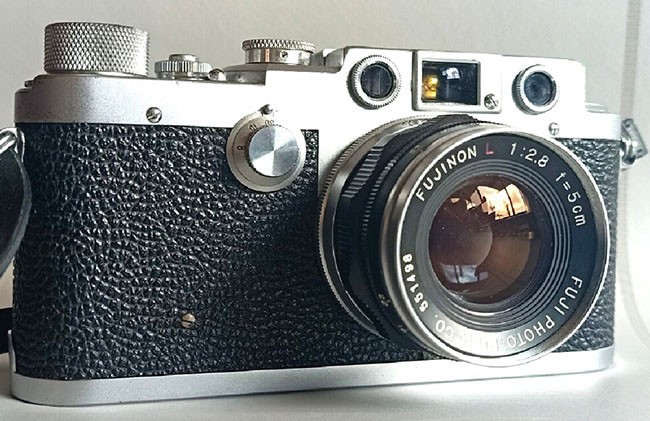
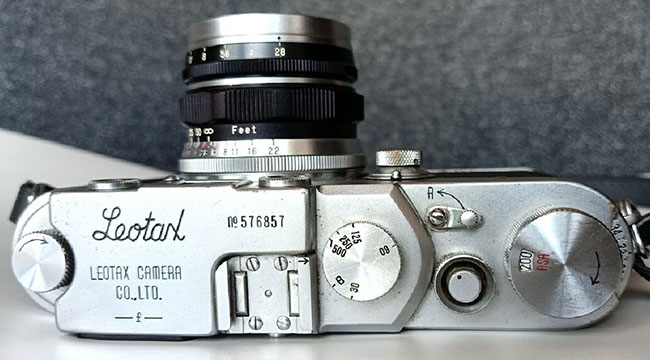
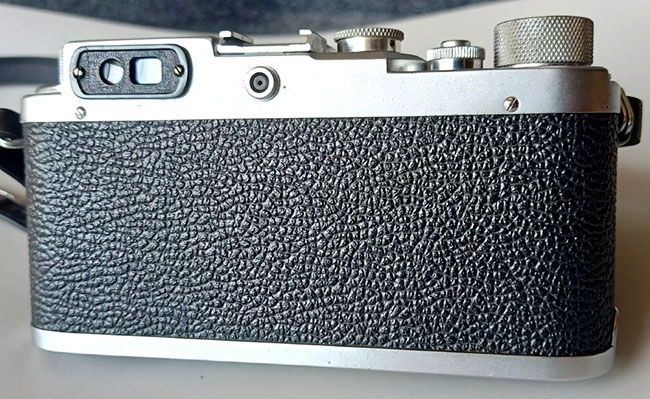
(Images courtesy of Bob Bazzoli)
Also released in 1958, it is the same as the T2 except that slowest of the slow speeds has been removed and the slow speeds now start from 1/8:
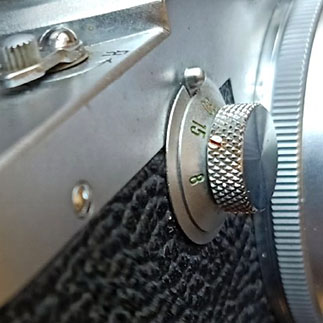

(Images courtesy of Bob Bazzoli)
Because there is no “1” second, the main dial changeover speed of 1/30 is simply marked “30” (in green) instead of the usual “30-1”.
According to both the Japanese Topcon Club website and Sugiyama, the standard lens is the Fujinon f/2.8 5 cm:
 (Detail from larger web image)
(Detail from larger web image)
The donor camera for this example with 551xxx serial number is unknown but is likely to be of Leotax K vintage, as is the one for the mounted example above, the found serial numbers of ones fitted to Leotax K3s are in the 553xxx to 554xxx range. Another page on the Topcon Club website (text opposite the K3) claims that one of the Leonon lenses was also offered - to me, the K3 seems far too early for the Leonons). Of the nine K3s found with likely original lenses in my database, six (not including the above example) feature the Fujinon f/2.8 and three the Topcor f/2.8 also found with the T2.
This K3 box is similar to the TV box:
 (Detail from larger web image)
(Detail from larger web image)
| “K3” Serial Numbers | |
|---|---|
From |
To |
| 57305x | 57799x |
Leotax FV
| Shutter Speeds (1/x) | |
|---|---|
Slow Speeds |
High Speeds |
| T, 1, 2, 4, 8, 15 | B, 30, 60, 125, 250, 500, 1000 |
| Typical Lens(es) Found | ||
|---|---|---|
Name |
Description |
Aperture |
| Fujinon | 5cm |
f/2.8 |
| Fujinon | 5cm |
f/2 |
| Topcor-S | 5cm black (aluminium) |
f/2 |
(Note, I haven't found any FVs fitted with either Fujinon but they are listed and pictured in the FV brochure below.)
This 1958 camera is the first of the third generation of the die-cast models. Building on the earlier improvements, the big change this time is the replacement of the film winding knob with a single stroke film advance lever. Accompanying that is further sophistication, the rewind knob has gained a rewind crank built into the top and the film counter now has its own window just in front of the film advance lever. The film speed continues to be displayed in a window on top of the central circular body of the lever. The shutter release is now at the front edge of the top plate and the rewind release is incorporated into the shutter collar. This is only the second model with a 1/1000 shutter speed and the last before the ill-fated G. A self-timer is fitted. It is the only die-cast model with the name engraved, the serial numbers have the prefix “FV-”
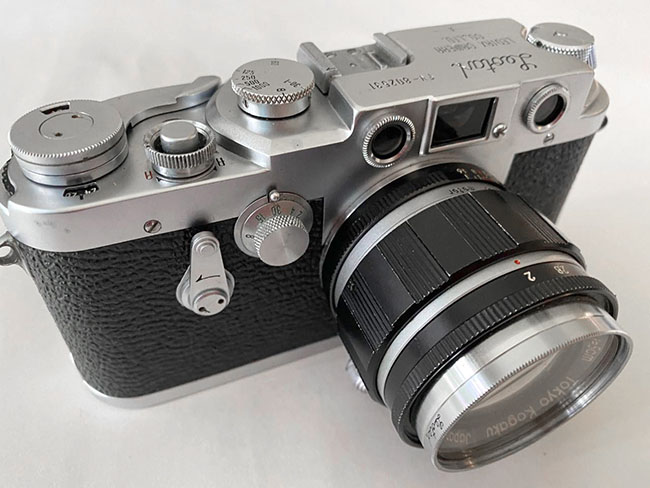
(Image courtesy of Gary Hill)
As an aid to close focusing, the FV is probably the first model to add parallax marks to the 50 mm frame of the new larger viewfinder introduced by the earlier knob-wind TV (they weren't there on the TV generation but are there on my later FV generation TV2).
The standard lens offered is the Topcor-S f/2 5 cm. According to the Japanese Topcon Club website, the FV arrived with the black and chrome panda version before changing to the new aluminium bodied black version but all the examples in my database are the later type, above and below (above view has Leotax filter mounted):
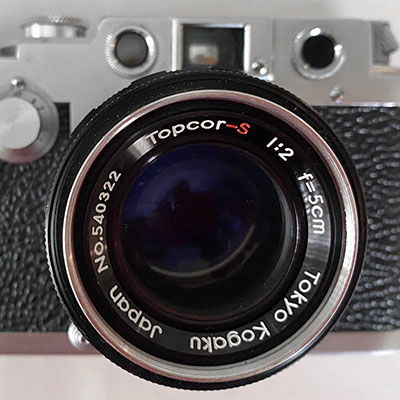 (Image courtesy of Gary Hill)
(Image courtesy of Gary Hill)
The construction is 6 elements in 4 groups, confirmed by both the TV2 User Manual and the FV brochure immediately below. Whilst the number of elements and groups remained constant in the various iterations of the f/2, there are said to be optical design changes. 10 bladed aperture diaphragm. The filter thread is 40.5 mm.
This FV brochure in Japanese lists lenses, lens hoods and filters. Like the TV2 user manual mentioned below, it also implies that both the Fujinon f/2 and f/2.8 lenses were also still offered but my database doesn't reflect that:
.jpg) (Scan provided courtesy of Gary Hill)
(Scan provided courtesy of Gary Hill)
(Click on cover for PDF of full brochure)
FV box introduces a new design used for the following TV2/Merite, T2L/Elite and Elite S2:
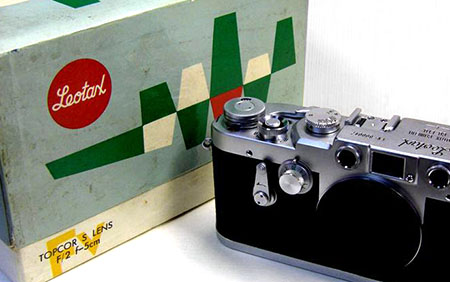 (Detail from larger web image)
(Detail from larger web image)
| “FV” Serial Numbers | |
|---|---|
From |
To |
| FV-57814x | |
| FV-80004x | FV-80435x |
There is only one example with the lower serial number and even though it looks out of place, the number is very clear and the camera has all the FV features:
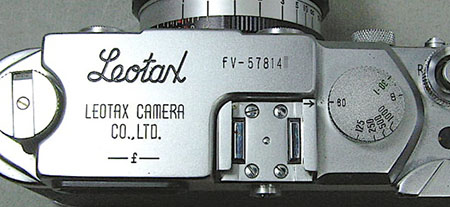 (Detail from larger web image)
(Detail from larger web image)
The previous generation TV and K3 seemed to share the same serial number range, both ending with 577xxx numbers (no prefix). This one seems to be a continuation of the series before Leotax switched to the new series for the FV. The serial number of the new black bodied aluminium Topcor-S lens, 54616x, also places itself at the beginning of the FV cameras.
Leotax TV2, later Merite (aka Merit, Leotax FV based)
| Shutter Speeds (1/x) | |
|---|---|
Slow Speeds |
High Speeds |
| T, 1, 2, 4, 8, 15 | B, 30, 60, 125, 250, 500 |
| Typical Lens(es) Found | ||
|---|---|---|
Name |
Description |
Aperture |
| Fujinon | 5 cm |
f/2.8 |
| Fujinon | 5cm |
f/2 |
| Topcor-S | 5cm black (aluminium) |
f/2 |
(Note, I haven't found any TV2s fitted with either Fujinon but they are listed and pictured in the TV2 user manual.)
Released in 1958 as the Leotax TV2, it is the Leotax FV including the self-timer but minus the 1/1000 top speed (now 1/500):
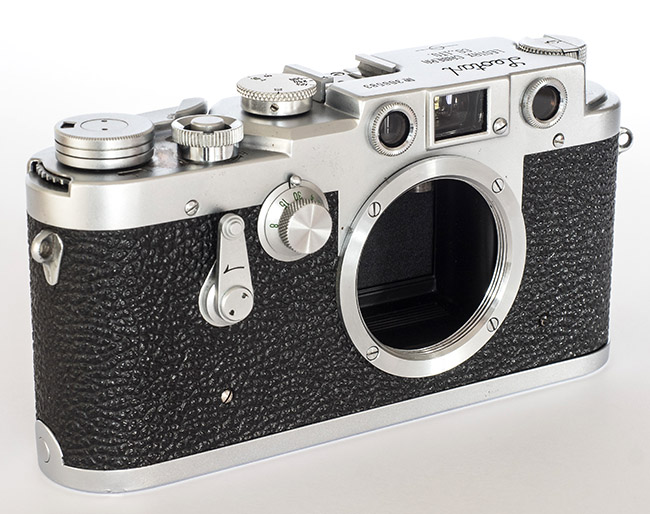
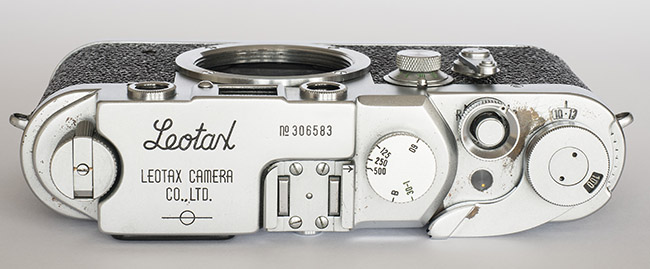
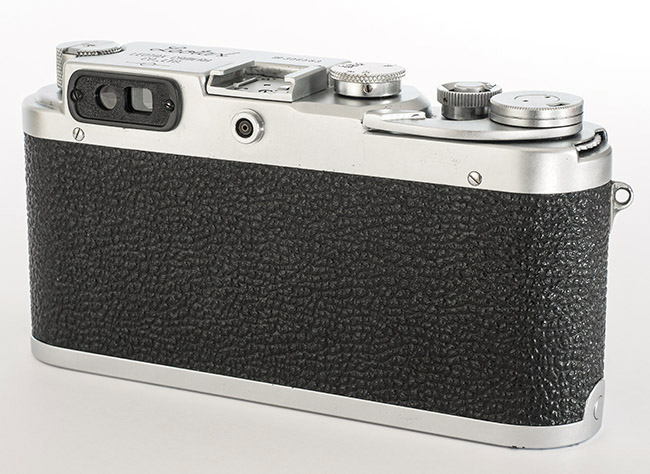

My understanding is that it was not called the Merite until the following Elite model was released in 1959. There are three differently labelled boxes. The first, below left, is labelled “TV2” along the bottom edge along with the lens details (similar to the same style Leotax FV box). The second features Japanese text which translates to “Merit” with the translator set to English, or to “Merite” with the translator set to French, again with the lens information. Whether it has any name on the opposite side is unknown but the Japanese name appears to be on a label, perhaps placed over the “TV2”?

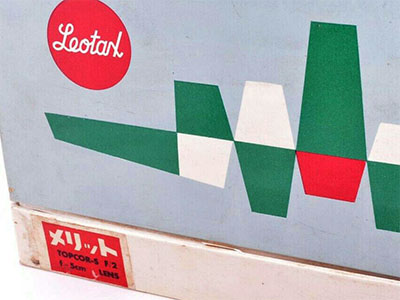
(Detail from larger web images)
The third box is labelled “Merite” in unambiguous Roman characters at one end and one side. On the other side and the other end is the Japanese name and lens details, this time, not on a label:

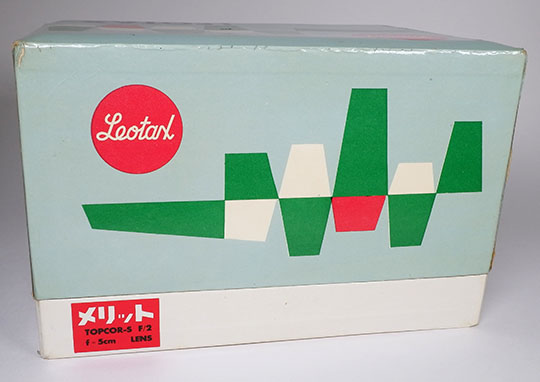
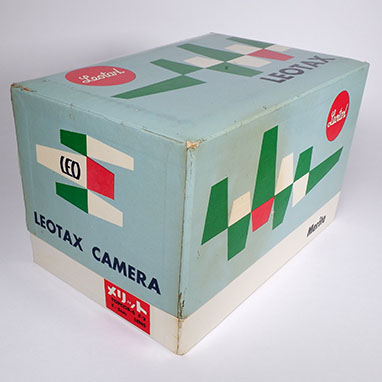
(Images courtesy of Chris Whelan)
I have seen two examples of the first box, three examples of the second and three examples of the third one, all for sale in Japan. Just to confirm that the displayed third box was intended for the Japanese market, it came complete with a Japanese instruction manual (the linked manual on this site still referring to the TV2). Here is a Japanese “Merite” brochure:
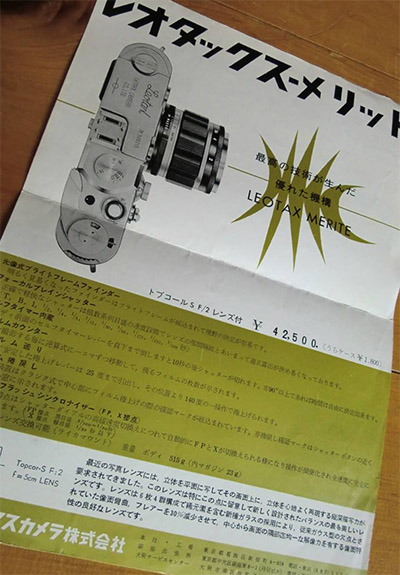
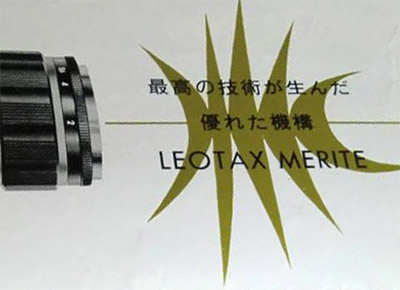
(Detail from larger web images)
Same as the Japanese text on the second box, the Japanese characters at the right end of the top line (cut off) translate to either “Merit”, or “Merite” depending on the language the translator is set to but the intent of the Roman text is clear.
Every source and reference, including Sugiyama, calls the camera “Merit” and given that there is probably not a direct translation from the Japanese word to English, certainly in terms of any nuances, that is probably understandable. However, I'm guessing that Leotax knew what it was doing, and even if it didn't, this is what the company called it. “Merite” is the French word for merit. Whereas “Elite” is an English word, its origins are French and there is also the French “élite”. Given that the names were coined at the same time, you would think that there was a connection.
In fact there was an earlier Japanese Leotax TV ad with the single word “Silhouette” apparently in English (apart from “Leotax TV”). Contributor Chris Whelan has pointed out that the origins of the word are French and that there is a pattern of usage here. “Silhouette” is a direct borrowing of the French word that came from the name of Louis XV's finance minister who was fond of making cut paper shadow portraits. In whatever context it was used in the ad is not clear to me but I think Chris is correct.
According to the brochure and my database, the standard lens was the aluminium bodied black Topcor-S f/2 5 cm but the Japanese TV2 user manual suggests that the Fujinon f/2.8 and f/2, featuring on the T2 and K3 and it seems also available on the earlier Leotax K, continued to be available.
| “TV2/Merite” Serial Numbers | |
|---|---|
From |
To |
| 30049x | 31387x |
Leotax T2L, later Elite (Leotax FV based)
| Shutter Speeds (1/x) | |
|---|---|
Slow Speeds |
High Speeds |
| 1, 2, 4, 8, 15 | B, 30, 60, 125, 250, 500 |
| Typical Lens(es) Found | ||
|---|---|---|
Name |
Description |
Aperture |
| Topcor | 5cm |
f/2.8 |
| Topcor-S | 5cm black (aluminium) |
f/2 |
| Fujinon | 5cm |
f/2 |
| Leonon (with Elite) | 5cm |
f/2 |
Released in 1959, it continues the pattern of introducing lower cost versions of major releases established by the previous generations. It seems that somewhat like the TV2, it was first released as the “T2L” with a mix of Topcor and the Fujinon f/2 lens offered and then changed it's name to “Elite” when fitted with the Leonon Lens (the latter 2/3 of serial numbers in my database). There are examples further below of both a box and papers with “T2L” name only and a box and brochure with “Elite” name only. Most of the Topcor lenses are the Topcor-S f/2 but two are f/2.8 examples and one has matching original papers (see below). The three Fujinon f/2 examples feature late numbers consistent with the period.
The T2L/Elite takes the FV and removes the 1/1000 top speed (now 1/500) and the FV and Merite “T” setting from the slow speed shutter dial and also their self-timers. Alternatively, it is a Merite without self-timer and “T”. Below is correspondent Gary Hill's Elite example with highest serial number in my database, 315001. It is shown with the Leonon-S lens from an Elite S2 mounted (plus a filter) but photos of a previous sale of this body feature the typical plain Leonon:
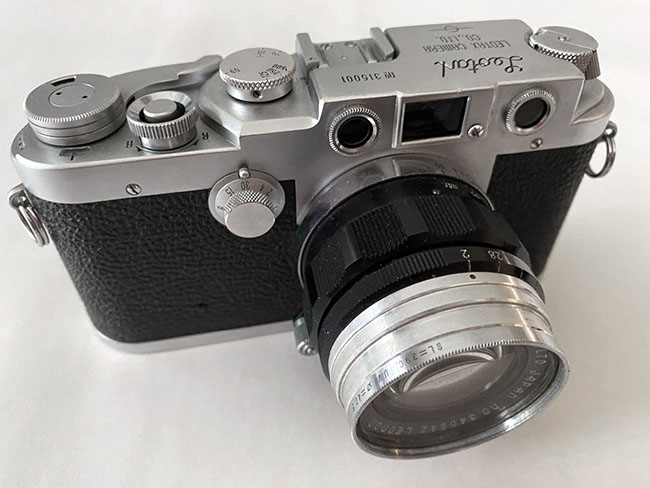
(Image courtesy of Gary Hill)
Top view of Elite with original plain Leonon mounted and whilst the profiles are similar, the ribbed area is wider and the bezels are different:
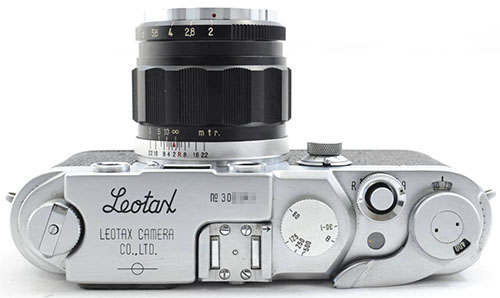 (Detail from larger web image)
(Detail from larger web image)
According to the “Elite” brochure below, the standard lens was the new “Leonon” f/2 5 cm (see Leonon Lenses below) and the price with lens was ¥28,000 plus ¥1,400 for the ever-ready case (it is also mentioned in the Elite S2 brochure further down with a new stamped price of ¥26,000 with the printed price of ¥22,400 crossed out, both plus the ¥1,400 for the case).
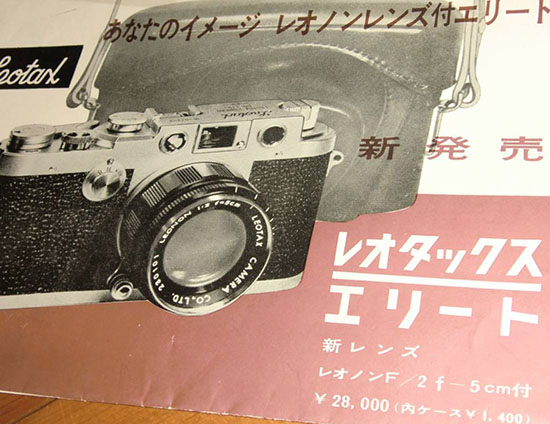 (Detail from larger web image)
(Detail from larger web image)
This T2L with Topcor f/2.8 lens was for sale as a complete kit with box, ever-ready case, user manual and two official appearing documents one of which is probably the guarantee document:
 (Detail from larger web image)
(Detail from larger web image)
Another photo shows the name on the box as “T2L Topcor S Lens F/2 f=5cm” so that seems to confirm the T2L link to Topcor at least. However, as noted, the actual lens attached is the f/2.8 version. That was presumably a low volume option and maybe didn't warrant a different box - the two documents certainly confirm the T2L model name, the lens name and aperture and the camera and lens serial numbers match those in the documents - all completely original:
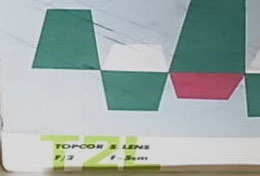
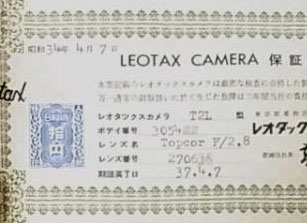
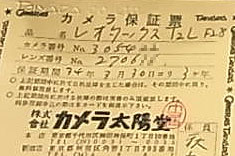
(Details from larger web images)
Here is a later Elite box for sale with its camera:
(Detail from larger web images)
The Japanese text just above “Leonon F/2” (same as at the bottom of the brochure) translates to “Elite”, there is no mention of “T2L”:
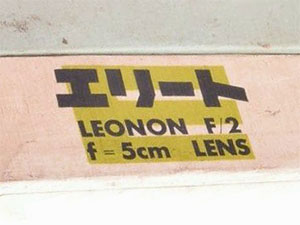 (Detail from larger web image)
(Detail from larger web image)
Even though it has a slightly lesser features/specs list, the T2L/Elite seems to share body serial numbers with the body variously marketed as TV2/Merite and Elite S2.
| “T2L” Serial Numbers | |
|---|---|
From |
To |
| 30052x | 30663x |
“Elite” Serial Numbers |
|
| 30172x | 31500x |
(Note, up to 30663x there are no bodies fitted with Leonon lenses, i.e. they are all T2L examples. After 30172x they are almost all fitted with Leonon lenses but two in my database are fitted with late Topcor-S f/2 lenses. If these are original fitments, quite possibly likely, then those two cameras would presumably have been marketed as the T2L model rather than Elite. In other words, there was unlikely to have been a hard cut-off between T2L and Elite versions and the table should be considered as indicative only of likely model name when identifying bodies without lenses.)
Leotax Elite S2 (Leotax FV based, TV2/Merite with Leonon-S lens)
| Shutter Speeds (1/x) | |
|---|---|
Slow Speeds |
High Speeds |
| T, 1, 2, 4, 8, 15 | B, 30, 60, 125, 250, 500 |
| Typical Lens(es) Found | ||
|---|---|---|
Name |
Description |
Aperture |
| Leonon-S | 5cm |
f/2 |
Sugiyama has confirmed the release dates of most of the previous models but no such help with the Elite S2. Japanese Wikipedia says 1960. It also says that Leotax became bankrupt in 1959 (according to Mikio Awano, October 1959) so this may have been a way to dispose of an excess supply of Merite bodies. The Japanese source Nekosan (cameraguild.jp/nekosan/leotax.htm - archived copy) says that both the Elite S2 and G were sold by the mortgager. Unlike with the TV2/Merite and T2L/Elite, the “S2” is unlikely to be a discreet model name but more likely to mean something like “Elite Series 2”. Below are photos of his Elite S2 and box supplied by correspondent Bob Bazzoli (he is the owner of the website masterpiececamera.com which amongst others, features the Italian Ducati half-frame cameras including the Sogno with a rangefinder and interchangeable lens):
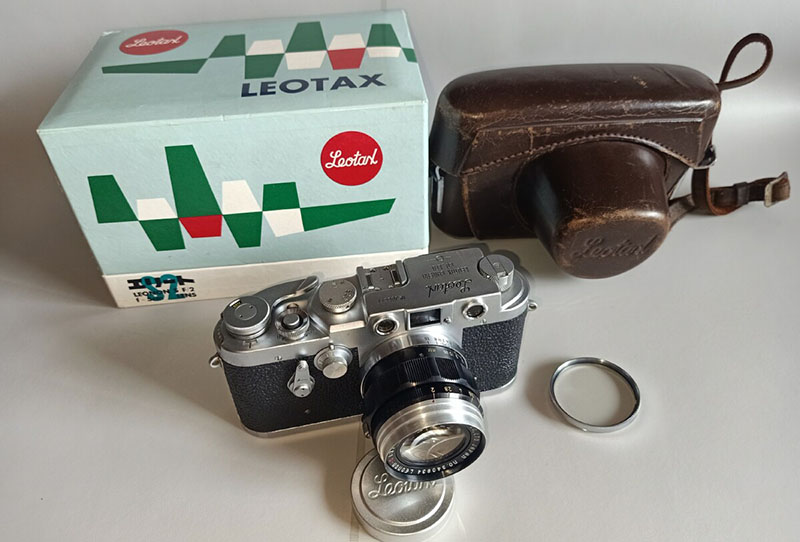

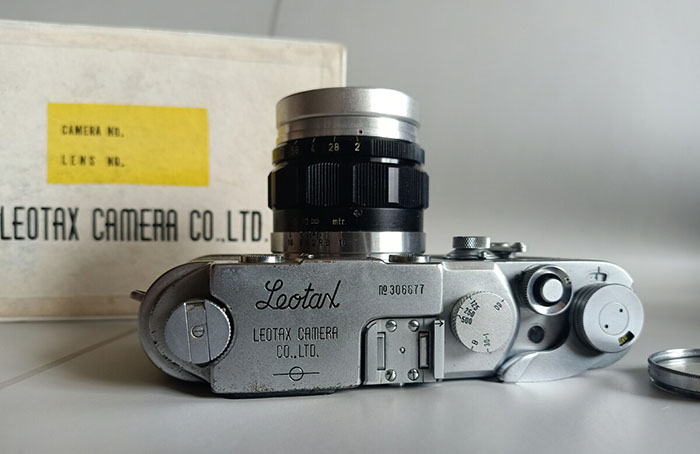
One end and one side of the box is marked “Elite” in English and the other side and end is marked with “Elite” in Japanese and “LEONON S F/2 f=5cm LENS” overlaying a large “S2”:
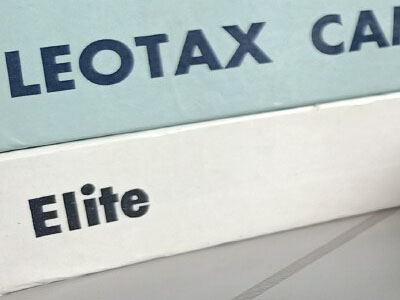
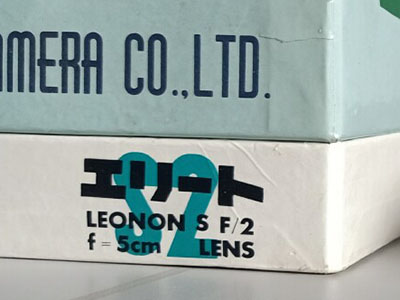
(Above images courtesy of Bob Bazzoli)
As far as a I can make out from the Merite brochure, the Elite S2 brochure below and photos, the only difference between the Merite and the Elite S2 is the lens, f/2 Topcor-S on the first and new f/2 “Leonon-S” on the second. And the price. ¥42,500 for the Merite (see brochure above) and ¥26,000 (over-stamped in ink, printed ¥24,600 crossed out) for the Elite S2 (the Elite S2 brochure also includes a price of ¥23,400 for the plain Elite with the plain Leonon lens which was previously advertised for ¥28,000, clearly, prices were plummeting). The Leonon-S will also become the little-known Yashica Yashikor f/2 (more further below including larger detail from the Elite S2 brochure).
.jpg) (Low resolution version of web image)
(Low resolution version of web image)
| “Elite S2” Serial Numbers | |
|---|---|
From |
To |
| 30667x | 31229x |
Note, the TV2/Merite, T2L Elite and Elite S2 serial numbers seem to be part of the same range and therefore if a body doesn't have a lens attached, it is impossible to know whether it is a TV2/Merite or Elite S2 by appearance alone. As the TV2 was launched two years earlier, low numbers almost certainly belong to a camera sold as a TV2 but if the lens was the only difference, with high numbers, it could be TV2, Merite or Elite S2 and really doesn't matter.
Leotax G
| Shutter Speeds (1/x) |
|---|
| T, B, 1, 2, 4, 8, 15, 30, 60, 125, 250, 500, 1000 |
| Typical Lens(es) Found | ||
|---|---|---|
Name |
Description |
Aperture |
| Topcor-S | 5cm black (aluminium) |
f/1.8 |
(As discussed further below, it is possible that some were supplied with the f/2 Topcor-S or Leonon f/2.)
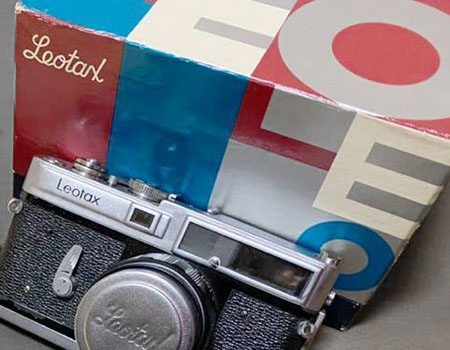 (Detail from larger web image)
(Detail from larger web image)
Leotax went bankrupt whilst developing the Leotax G. According to Japanese Wikipedia, a sub-contractor assembled 500 cameras from parts and the cameras were sold in 1961 by Rokuwa, a Japanese photographic goods distributer also responsible for “Minori” brand photographic items, presumably on behalf of the mortgager. I have a downloaded Rokuwa flyer advertising “new product Leotax G has been released from Rokuwa” and listing the features and specs. Although it was also 1961 that Canon released its most successful rangefinder model, the Canon 7, the Leotax G was too little too late to compete with either Canon or the promise offered by SLRs and there was no interest in interchangeable lens rangefinders from lesser known makers at even giveaway prices.
The Leotax G owes very little to its predecessors apart from the lens mount and shutter and even that now featured all the full range of speeds from T to 1/1000 on the single top dial which doesn't rotate when the shutter fires (the yellow marked slow speeds are not visible in the photo below, see further down). If it would have been released earlier, its natural competitor might have been the similarly specified very successful 1959 Canon P, the Nicca III-L lagging both in features, although in lens offerings, the Leotax was at a definite disadvantage. It features lever wind and an auto reset film counter. The parallax corrected viewfinder arrangement was reminiscent of the Nikon SP with the larger right side (photographer's view) viewfinder featuring projected bright line frames for 50 mm and 90 mm lenses and the combined rangefinder spot and left side viewfinder featuring a frame line for 35 mm. The camera back was now side hinged fully opening in the style that had become ubiquitous on everything but the Leica M series which featured an opening flap instead. The unusual fixed bottom plate with hinged opening was designed to enable use of the mechanically opened reusable film casettes:


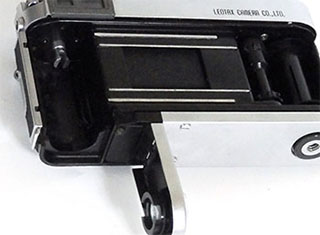

(Detail from larger web images)
Two different shutter dials have been observed. Most look like the one on the left, the one on the right was found in the middle of the serial number range (90172x). As well as the colours, there are at least five “slots” in the ribbing. Their purpose is unknown but it is possible that Leotax had been toying with an accessory meter coupled to the shutter dial:
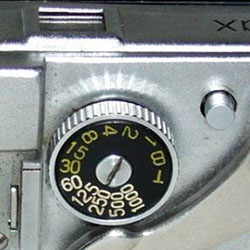
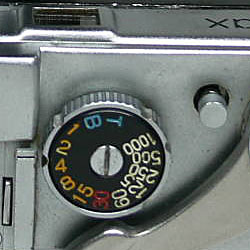
(Detail from larger web images)
The Rokuwa flyer tells us that the speeds displayed in white are FP sync and the speeds displayed in yellow are X sync
The standard lens was a new Topcor-S f/1.8 5 cm that looks very similar to the aluminium bodied f/2 including the 6 elements in 4 groups optical design, 10 aperture blades and 40.5 mm filter thread but the front elements are noticeably different.
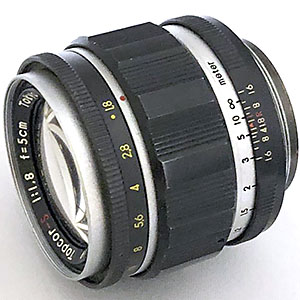 (Detail from larger web image)
(Detail from larger web image)
The Topcon Club website suggests that a cheaper Leonon f/1.8 was also available but I'm not sure that is correct. I can't find any references to one anywhere, perhaps they mean the f/2 version? Certainly, three of the Leotax Gs in my database are fitted with the plain Leonon and two with the Topcor-like Leonon-S but I don't know if they are original, or not. Also, as well as 7 with f/1.8 Topcor-S lenses, 3 Gs are fitted with the f/2 version. It is possible that available lenses were simply being used up.
It is said that the quality of assembly was not up to Leotax factory standards and problems are experienced quite often with the film transport and rewind mechanism particularly. Consequently, although very collectible these days, they are difficult to find in good condition. However, here is a very nice example owned by correspondent Gary Hill, this one fitted with accessory soft shutter release button and the Topcor f/2.8 3.5 cm wide angle lens:
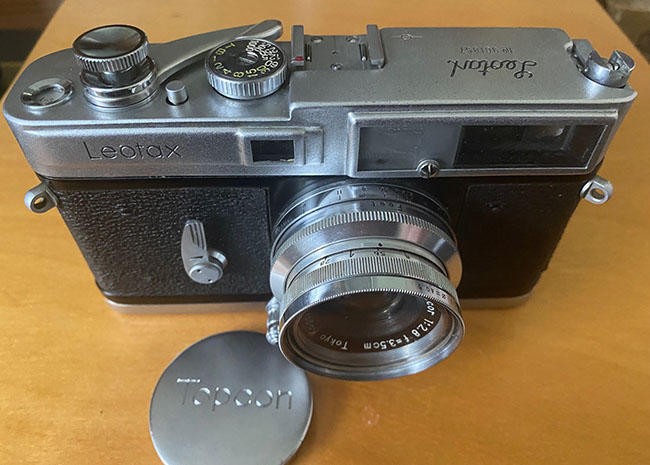
(Image courtesy of Gary Hill)
| “G” Serial Numbers | |
|---|---|
From |
To |
| 90105x | 90207x |
| 90587x | |
The first range covers about 1020 possible serial numbers and the 18 cameras that I have found are fairly evenly distributed. There is only one example of the 905xxx range, that is an outlier for some reason:
 (detail from larger web image)
(detail from larger web image)
If only 500 cameras were assembled as claimed, the serial numbers are clearly not consecutive. However, it is possible that there were over 1,000 numbered top plates but for some reason, perhaps shortage of other parts or economic considerations, only 500 were completed.
However, I'm also a little surprised that I have been able to find 19 examples in a relatively short period of time without searching too hard. The Rokuwa flyer clearly advertises the Leotax G complete with f/1.8 lens but about half of the examples in my database found with lenses feature the f/1.8 and the other half are fitted with an assortment of late model f/2 Topcor and Leonon lenses. Maybe the 500 referred to the camera/lens set as boxed and promoted but there were more bodies sold using up existing lens inventory? Note that there is no hard evidence for that and hence it's not even a theory, just a guess at a possible explanation.
The late f/2 Topcor-S, Leonon & Leonon-S Lenses
My Leonon journey of discovery started with investigating the origins of the obscure Yashikor f/2 5 cm lens below (on the YE & YF page is the full story including how Japanese authority Mikio Awano led me to the connection between the lenses ):
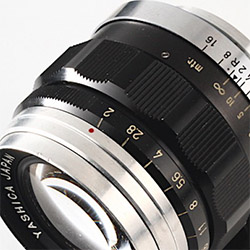 (Detail from larger web image)
(Detail from larger web image)
The Yashikor is clearly the same lens as the Leonon-S lens mounted here on a Canon VL2 camera:
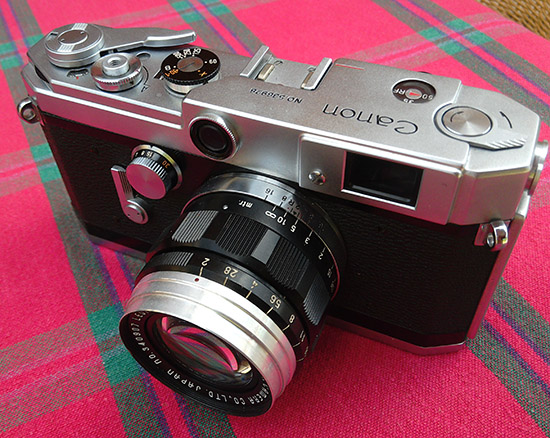
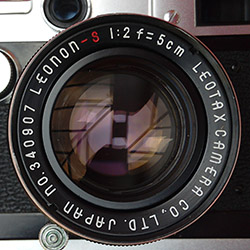
(Images courtesy of photo.net member aleceiffel)
As well as the same overall appearance, both lenses share these slightly unusual 10 wavy aperture blades:
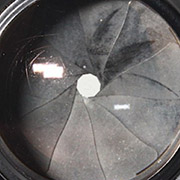 (Detail from larger web image)
(Detail from larger web image)
They are certainly not unique though, the same shape blades are found on most/all versions of the rigid Leitz 50 mm f/2 Summicron and the Minolta 35 Model II & IIB 5 cm Rokkors (1954 to 1958) featured similar, more aggressively angled blades as did at least the Canon 50 mm f/1.4 and 35 mm f/1.8 rangefinder lenses.
There are actually three lenses named “Leonon”, one plain and two ending in “-S”. All are presumed to be budget replacements for the f/2 Topcor-S as selling rangefinder cameras became progressively more difficult towards the end of the 1950s.
In summary, as far as I can tell, the 5 cm lenses fitted to late model Leotax models in chronological order are:
- The last supplied f/2 Topcor type is aluminium bodied, has 10 straight aperture blades and is named “Topcor-S”:
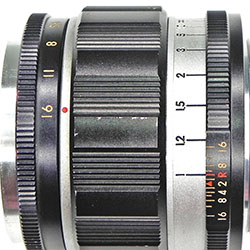
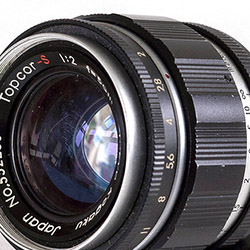
(Detail from larger web images)
- There is a fairly rare “Leonon-S” that looks very much like the Topcor, except for the ribbing and the plain DoF ring. The aperture blades also seem to have a straight edge in two unclear images. Both have aperture ranges of f/2 to f/16. Both have three screws in the flange face and very similar/same rear end construction. However, the front glass is smaller and noticeably set deeper. My guess is that it is perhaps a budget version developed by Tokyo Kogaku, perhaps with simpler optical formula? Two have been found with Leotax F examples, one with a Leotax TV2/Merite, one with a Leotax T2L/Elite, the Elite version of which was advertised with the next type plain Leonon, and two with Leotax G examples. Certainly, the lens is far newer than Leotax F. Both the camera body and lens serial numbers of the Leotax G examples are relatively close and the lens numbers are higher than for TV2/T2L pair, which is to be expected if the lenses were original fitments. It is the only Leonon model type that I can't definitively link to a particular Leotax body. It is possible that it was offered as a lower cost option on bodies that would more normally have been supplied with the aluminium bodied Topcor-S f/2 whereas bodies fitted with the other Leonon and Leonon S lenses took on a new model name when fitted with those, i.e. Elite (T2L body) and Elite S2 (TV2/Merite body). The serial numbers of the 6 examples in my database range from 59033x to 59101x, i.e. probably a little over 1,000 lenses.
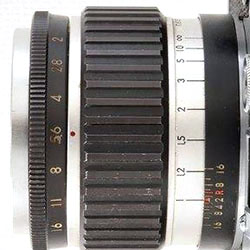
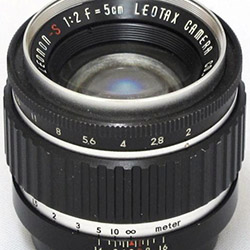
(Detail from larger web images)
- There is a relatively common plain “Leonon” (no “-S”) that mostly features the same (or at least very similar) 10 unusual aperture blades as described above but the earliest production versions in my database have 10 curved blades (serial numbers 23031x and 23033x). From a Leotax brochure, the Leonon is a 6 elements in 5 groups Gauss type with an aperture range of f/2 to f/22 (in this group, the odd one out). This is the “new” standard lens for what I presumed was the 1959 Leotax T2L Elite but it may be that there are actually two models (a number of earlier examples are fitted with the black Topcor-S, perhaps the T2L featured the Topcor-S and the “Elite” derivative, the Leonon). The serial numbers of the 38 examples in my database range from 23031x to 23371x, i.e. probably a little under 4,000 lenses.

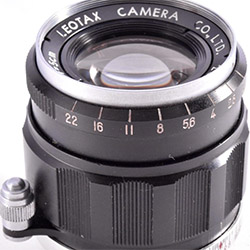
(Detail from larger web images)
- Finally, there is the Yashikor doppelganger that features the 10 unusual aperture blades of the plain Leonon (and the Yashikor) but is called “Leonon-S” like the first more rare type. The aperture range is f/2 to f/16 as on the Topcor-S and its namesake. This is the “new” standard lens for the 1960 Leotax Elite S2 (TV2/Merite when fitted with Topcor-S). The serial numbers of the 25 examples in my database range from 34011x to 34150x, i.e. probably a little over 1,500 lenses.
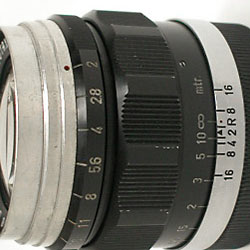

(Detail from larger web images)
Although not visible in most of these photos, all the lenses are fitted with focus assist levers but not infinity locks.
And what does the “S” mean on three of the four lenses? If they were Nikkors, they would be 7 element lenses as at least one blog has suggested. A Popular Photography ad from April 1957 tells us that the all chrome Topcor-S is in fact 6 elements and the Japanese brochure (further above) and user manual (further below) for the Leotax TV2 confirm the same with a schematic for the new aluminium bodied type which shows it to be a 6 elements in 4 groups double Gauss design. We know that the plain Leonon has 6 elements in 5 groups. But what of the two Leonon-S types? They may be 6 element too but we don't know.
The Leonon and second Leonon-S feature a 40.5 mm filter thread shared with the Topcor-S so presumably, the first Leonon-S does too.
It seems to me that the two later Leonons at least are different enough to not be typically Tokyo Kogaku made. There is nothing about them that suggests production by a premium maker, more that they are built to a price which is almost certainly the reason for their appearance on the Leotaxes and the Leonon-S also as the f/2 Yashikor on the YF. Although who knows?
Several Japanese web & blog sites, including the respected Topcon Club (text opposite the K3) and Koujiya Camera referenced by both Camera-wiki.org and Camerapedia, claim that “the Leonon lens” (all three, two, one?) was made by Showa Koki (not related to Shōwa Kōgaku). Showa Koki had been an independent lens maker before being acquired by camera maker Aires at the end of 1953. It made “Coral” brand lenses but is known to have made only one LTM lens, an f/1.9 4.5 cm “Piotar”, probably featuring a similar/the same optical construction as its well regarded “Coral” f/1.9 4.5 cm lenses on fixed lens Aires rangefinders. So no obvious connection to support the claim but nothing to disprove it either.
Below is part of a brochure advertising the “new” Leonon-S (the last type above) as the standard lens for the Leotax S2 Elite, Interestingly, the lens in the brochure has all the physical characteristics of the Leonon-S, including the distinctive stepped bezel, but the front make up ring is typical of the plain Leonon and is complete with a crudely added and cramped “S” in white (instead of red) but missing the “Japan” commonly found on both Leonon-S lenses. It also has a typical plain Leonon serial number (23xxxx vs 34xxxx). Perhaps the plain Leonon developed into the Leonon-S and this is a doctored photo of a prototype? Enlarged lens detail on right:
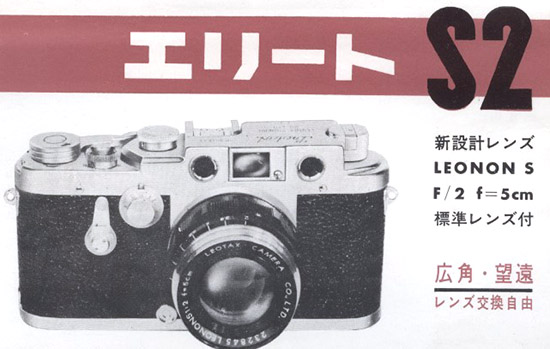
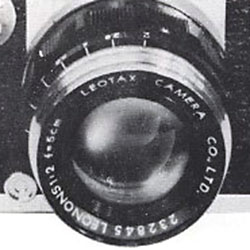
(Brochure details from larger web image)
Lenses Overview
Lenses found with particular camera models have already been covered in the discussions about the models and also in the section just above. This is a more general overview of lenses supplied with/available for Leotax cameras.
Letana (Fujita)
According to Sugiyama, the lens on the original Leotax (the first hand built 50 after the initial prototypes) was made by Fujita. Of two companies with that name, according to Camera-wiki.org, the company was most likely lens maker Fujita Kōgaku Kikai which was also responsible for the Rieze lenses on the early Semi and Baby Leotaxes.
Camera-wiki.org lists the Letana lens (“Letana Anastigmat”) fitted to the Leotax as also Fujita Kōgaku Kikai made. Some people seem to believe that Shōwa Kōgaku itself was responsible for the Letana lens but the reference quoted by Camera-wiki.org is the “Kokusan shashinki no genjō chōsa” (Inquiry into Japanese cameras) which was a Japanese government inquiry into Japanese camera production as of April 1943, a pretty impeccable source.
State, C.Simlar, Simlar & Topcor (Tokyo Kogaku)
Tōkyō Kōgaku Kikai K.K. (Tokyo Optical Company, Ltd.) was established in Hasunuma-cho, Itabashi-ku, Tokyo in 1932 and started making lenses in 1935. Initially producing mainly larger format lenses and, during the War, large aperture lenses for the military, the company turned to LTM lenses after the War. Having earlier dabbled in camera production with the “Lord” and then “Minion” 4x5 cm folders from 1938 to 1943 and then again after the War, it produced its first 35 mm camera in 1948 and in 1950 began production of its Topcoflex TLR, mostly marketed as the Primoflex and Laurelflex.
Nearly all of the references say something vague like “Tōkyō Kōgaku made lenses for Japanese Leica copies, mostly for Shōwa Kōgaku”. Standard or normal lenses in the 5 cm/50 mm range were supplied with camera bodies and rarely, if ever, sold by themselves. So far, I have not found any other likely customers for Tōkyō Kōgaku made 5 cm lenses. Also, its wide angle and telephoto accessory lens range was limited to three lenses and an earlier low volume telephoto all of which rarely turn up these days indicating that not many were made. I have found no separate ads for them (apart from appearing with Leotax cameras) and have to wonder whether Tōkyō Kōgaku ever marketed them directly, or whether they were only supplied to Shōwa Kōgaku.
Tōkyō Kōgaku lenses appeared on Leotax cameras after the War first branded “State”, then “Simlar”, “C.Simlar” and finally back to “Simlar” before they became “Topcor”. According to various sources, the “Simlar” name comes from “Shimura”, an area near the Tōkyō Kōgaku factory. The “C” in “C.Simlar” is red and certainly stands for “coated”. The progression of the Simlar name and back again only appears with the f/3.5 5cm lens. It makes sense in as much that the lens was uncoated when released, it was given the “C” when coating was introduced around 1947 with the release of the Leotax Special D III and then when coatings became ubiquitous, it was dropped in 1951 with the release of the Leotax D IV (earlier f/3.5 Simlars and C.Simlars featured f/18 minimum apertures with the old aperture scales and “50 mm” focal length markings, later f/3.5 Simlars featured f/16 minimum apertures with the new scales and “5 cm” markings). As far as I am aware, apart from the very early C.Simlar 9 cm telephoto below, neither the later f/1.5 5 cm lens nor any of the Topcors indicated that they were coated but clearly are.
Before the Topcor series, lenses were marked with the maker name “Tokyo Opt. Co.” (short for the Anglicised “Tokyo Optical Company”) but the later Topcor lenses mostly feature the Japanese “Tokyo Kogaku”.
The first C.Simlar and Simlar lenses were the collapsible f/3.5 5 cm Leitz Elmar types and the State looked like one and probably was too but by at least 1950, the rigid chrome Simlar f/1.5 5 cm was being offered on the Leotax D IV. At some point the f/1.5 lens was revised slightly. In 1955, they were renamed “Topcor”. In 1956, the f/3.5 lens was redesigned from Elmar to Tessar type and the chrome Topcor f/2 5 cm lens (6 elements in 5 groups) was added to the range. It was replaced by the new chrome Topcor-S f/2 (6 elements in 4 groups) in 1957 and updated to the black and chrome panda version in 1958.
Note: All versions of the Topcor-S f/2 5 cm feature an optical design of 6 elements in 4 groups (the last type black aluminium bodied lens is confirmed as that in the Leotax TV2/Merite user manual), not 7 as some have guessed. This lens is a Topcor, not Nikkor and “S” does not mean “Septem” for seven.
Earlier, in 1955, a rigid aluminium version of the collapsible Elmar type f/3.5 was released with the Leotax K. It was redesigned as a Tessar type at the same time as the collapsible version. The lens didn't seem to be offered on any other models.
By the time of the Leotax TV in 1957, the large aperture f/1.5 and collapsible f/3.5 lenses seemed to be no longer offered. The Topcon Club notes that Nicca had joined the die-cast club, SLRs were making inroads and that the f/1.5 lens, like similar lenses from competitors, was very expensive and basically priced itself out of the market.
The black aluminium barrelled Topcor-S f/2 5 cm was released in 1958 and when the Leotax G finally made it to market in 1961, its main lens offering was a black Topcor-S f/1.8 5 cm with a very similar appearance but different design to the f/2 version.
Also released in 1958 was the first, rare and short-lived f/2.8 5 cm Topcor, a 5 elements in 3 groups design, which is claimed to have been destined only for the Leotax T2, even though that model is found mainly with Fujinon f/2 and f/2.8 lenses. It does seem to also appear on the sibling, and slightly more budget, K3 (fewer slow speeds). However, it is odd that a budget lens is so rare that after the cost of development, it didn't survive into the new austerity era. Perhaps there was an issue with some of its novel features like turning the lens hood into a cap with one touch, or it may have been too expensive for its spec, or there may have been performance issues, or maybe it arrived late.
Topcor Wide Angle & Telephoto Accessory Lenses
The arrival of the accessory lenses is not as well documented. The Japanese Nekosan website has a photo of a C.Simlar f/4 9 cm lens which they say was made in very small numbers during the D II era in 1947-48. On the left, Leitz Elmar inspiration and the C.Simlar on the right, both said to be 4 element Tessar designs (there are 3 element Elmars):
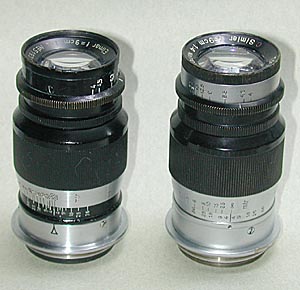 (Image from Nekosan website, appears to be defunct)
(Image from Nekosan website, appears to be defunct)
The only wide angle lens was the Topcor f/2.8 3.5 cm, a 6 elements in 4 groups design, which came complete with monstrously sized accessory viewfinder. The Topcon Club website thinks it was released about 1955:
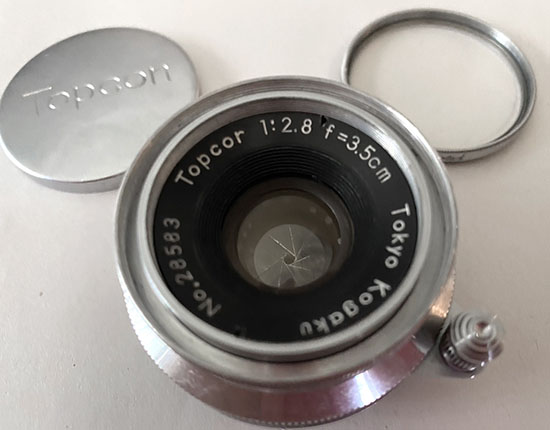
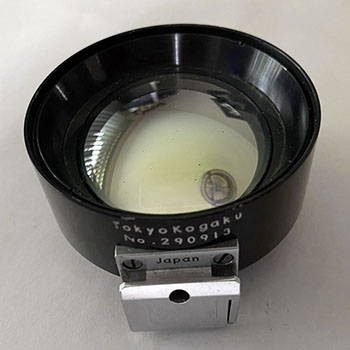
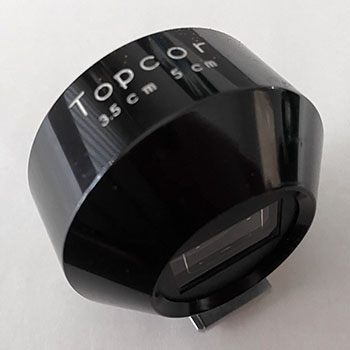
(All three images courtesy of Gary Hill)
Next were the aluminium bodied f/3.5 9 cm and f/3.5 13.5 cm Topcor telephotos. The 9 cm is thought to have been released in 1956 but could be earlier. The commonly found later version bears a strong design resemblance to the rigid f/3.5 Leotax K lens released in 1955. According to the Topcon Club, there are two noticeably different coatings used. I think the translation says it came with its own viewfinder but apparently the multi-frame 13.5 cm version is easier to use. The 3 element optical design sounds modest, as it is, but is probably similar to the Leitz Elmar f/4 9 cm 3 element model (some 9 cm Elmars are 4 element types) and both have good reputations. The 9cm lens with chunky aperture and focusing rings is on the left, the finer ribbed Topcor f/3.5 13.5 cm telephoto is on the right:
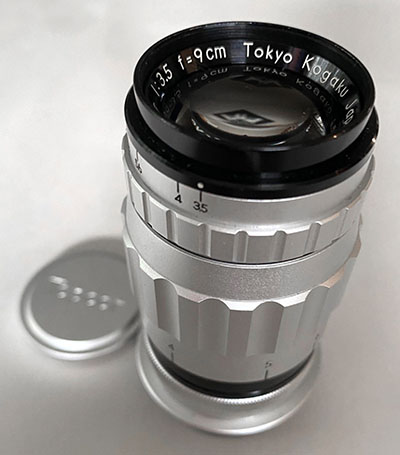
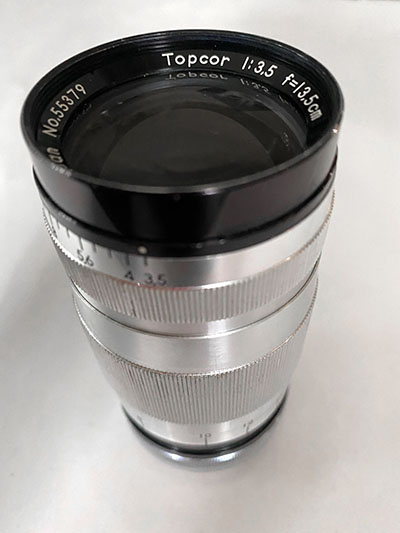
(Images courtesy of Gary Hill)
The 13.5 cm with matching lens hood mounted:
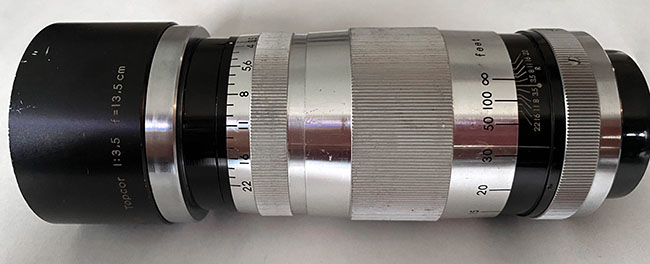
(Image courtesy of Gary Hill)
Several Showa Optical Works/Leotax documents from 1955 or 1956 show photographs of the two lenses with silver noses and the 9 cm lens with the same fine ribbing as the 13.5 cm lens:
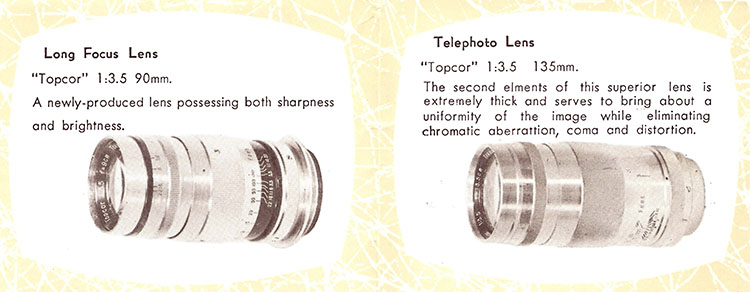
(From Gary Hill's Showa Optical Works Leotax F brochure)
The brochure seems to imply that the 9 cm is the newer lens of the two. I haven't seen any examples of either early version in the wild but the two different 9 cm lens types might be connected to the reference to two different coatings mentioned earlier.
Below is the lens range from a 1957 Japanese Asahi Camera ad (shown full size and similar to a Popular Photography April 1957 ad for the Leotax F and K):
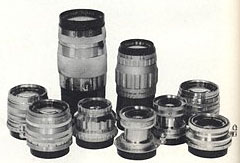
Back row left to right are the later type 13.5 cm and 9 cm lenses. Extreme front right is the 3.5 cm lens, the rigid f/3.5 5 cm Leotax K lens is in front of the 13.5 cm lens and at that point, there may be some doubling up. There appear to be two identical Tessar type f/3.5 5 cm collapsible lenses and there are three chrome barrelled 5 cm lenses, one of which may still be the f/1.5 (whilst the group might include the two Konishiroku lenses, see below, the ad only refers to Topcor lenses).
The selection of lenses in the Leotax TV2 user manual is different and is shown in Fujinon (Fuji Photo Film) below. In that, the 13.5 cm lens seems to be discontinued already but these are the two accessory finders offered:
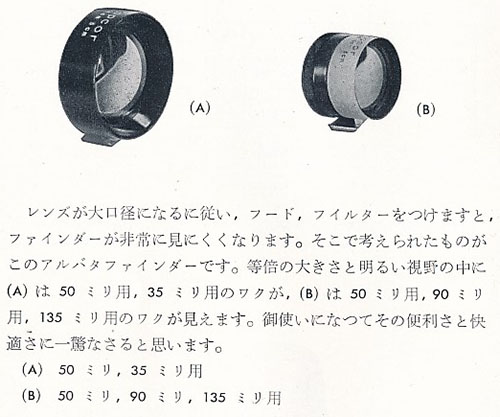 (Scan courtesy of Chris Whelan)
(Scan courtesy of Chris Whelan)
(A), which is the type pictured above, has frames indicating the fields of view of 50 mm and 35 mm lenses and (B) has frames indicating the fields of view of 50 mm, 90 mm and 135 mm lenses. That seems to confirm the earlier comment that the multi-frame finder that came with the 13.5 cm lens originally was more convenient - it seems to have replaced the 9 cm version completely.
The earlier finder for the 9 cm lens is shown alongside the 50/90/135 mm (B) version from above:
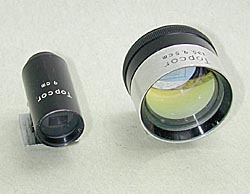 (Image from Nekosan website, appears to be defunct)
(Image from Nekosan website, appears to be defunct)
Zuiko (Olympus)
As noted earlier, this f/2.8 4 cm lens and its matching finder featured in the ad for the 1950 Leotax D IV. As a 5 elements in 4 groups design from a company with a good reputation, it is likely to be an excellent performer. It is a bit too long for a typical wide angle lens and seems to have been offered as an alternate wider angle standard lens, somewhat ahead of its time. Even so, it's appearance in the Leotax lens portfolio may have been due to the lack of a suitable wide angle offering by Tōkyō Kōgaku, still about five years away. I have no idea about how long the Zuiko was offered for but the Camera-wiki.org article believes that it was probably only made from 1950 to 1951, 1952 at the outside. Nevertheless, there were some detail changes and a revised barrel. This lens was advertised separately by Olympus so it was by no means exclusive.
Hexar & Hexanon (Konishiroku, later Konica)
As well as the evidence noted earlier, the Leotax T user manual (originally downloaded from a Japanese site where it is no longer available), confirms that the f/3.5 5 cm Hexar and f/1.9 5 cm Hexanon were offered on the 1955 Leotax T:

The appearance of the two lenses may seem somewhat odd as they seem to parallel Tōkyō Kōgaku's range. As the top model of this generation, the Leotax F arrived in 1954 with Tōkyō Kōgaku's top offering of the Topcor f/1.5 lens and the f/3.5 as the budget alternative. With an obvious gap in the range at around the f/2 aperture mark and the arrival of the Topcor f/2 still 2 years away in 1956, it seems that Shōwa Kōgaku turned to Konishiroku to fill the gap. Interestingly, the price of the Leotax F with either Topcor f/2, or Hexanon f/1.9, was the same. Whatever the policy was, these days the Konishiroku lenses are more likely to be found on the cheaper Leotax T.
Whereas the Hexanon f/1.9 makes sense, why the f/3.5? Konishiroku was a quality lens maker so there was unlikely to be a saving. Perhaps it was part of a package deal that was negotiated? Once the Topcor f/2 arrived the Konishiroku period seemed to come to an end, at least as far as being offered as a standard lens option on subsequent models.
The Camera-wiki.org article, Konishiroku Lenses in Leica Screw Mount, tells us that the f/3.5 Hexar was the standard lens on the Chiyotax IIIF and a budget alternative to the Nikkor f/2 on the Melcon. The f/1.9 Hexanon was offered as an alternative on the Chiyotax. Both lenses were also offered on the Honor S1. None of these cameras achieved high volumes so Konishiroku was probably very keen to find additional customers. The really interesting thing about the article is that apparently, Konishiroku didn't sell either lens directly (being typical standard lenses, that is hardly surprising, they normally come with a camera) but there are ads that indicate that Shōwa Kōgaku did. Perhaps that was also part of the deal?
Fujinon (Fuji Photo Film)
Another mystery are the Fuji Photo Film f/2 and f/2.8 5 cm lenses. They appeared on the 1958 Leotax T2 and K3, both cheaper versions of this generation's flagship Leotax TV. This part of the story may be a reverse of the Konishiroku experience. Whereas the f/2 now seems like an unnecessary doubling up of this aperture, it may have been the f/2.8 lens that Shōwa Kōgaku really wanted.
Fuji Photo Film made a small range of LTM lenses. It made a couple of 3.5 cm lenses, one of them an f/2, an f/2 10 cm and an impressive f/1.2 5 cm lens, also available in Nikon S mount, all of which would have been competing in the accessory lens market. It also made the f/2 and f/2.8 5 cm lenses - who was the customer for these? No doubt Fuji Photo Film would have been keen to sign a contract with Shōwa Kōgaku.
There is only one problem with where my story is heading. In 1958, the T2, and it now seems the K3 too, were also offered with the new Topcor f/2.8 5 cm lens so more doubling up. However, as noted earlier, this lens is extremely rare so for some reason, the Fujinon seems to have been preferred.
The T2 and K3 are the two models associated with the Fujinons, although there is concrete evidence that at least the f/2.8 appeared earlier on late examples of the Leotax K (8 examples and a Leotax “Inspected Card”) and the f/2 also is fitted to one and was fitted to at least some similar vintage Leotax T examples in my database as was one f/2.8. From the Leotax TV user manual (originally downloaded from a Japanese site where it is no longer available):
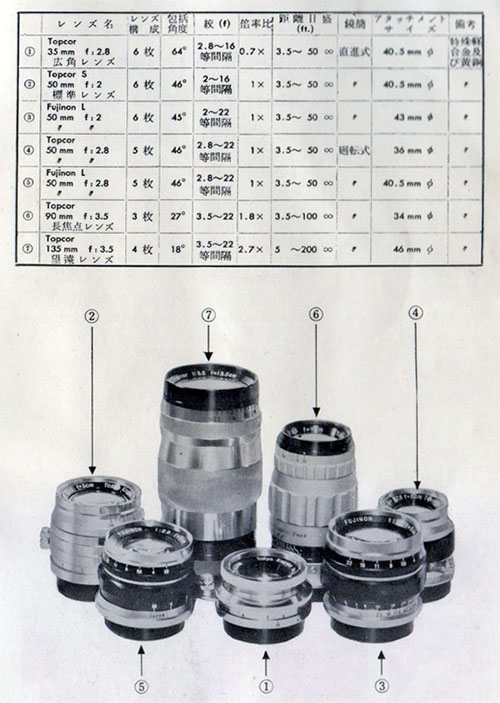
Below is the lens selection from the Japanese Leotax TV2 (later called Merite) user manual. This model was also released in 1958 but is part of the new FV lever wind generation. Its standard lens is thought to be the aluminium bodied Topcor-S f/2 but both Fujinons are also still there, although none appear in my database:
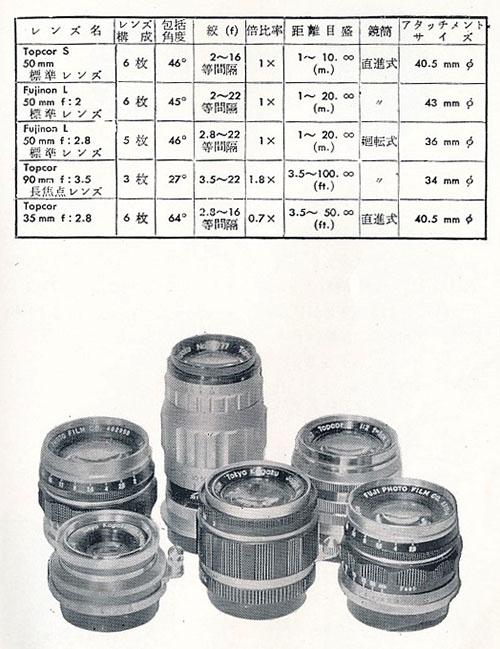 (Scan courtesy of Chris Whelan)
(Scan courtesy of Chris Whelan)
However, the more budget version of the TV2, the T2L/Elite which mostly features the f/2 Leonon lens, early on was mainly supplied with the Topcor-S lens and my database also includes three Fujinon f/2 lenses in close company, all with consistent late serial numbers. So as well as arriving earlier, the Fujinons hung around longer than is generally realised.
Notably, there is no mention of the Topcor f/2.8 in the TV2 user manual so it was short-lived indeed. Also, the Topcor 13.5 cm seems to have been dropped (also missing from the FV brochure scanned by Gary Hill). However, not listed separately but snuck in the back on the right is the earlier all chrome version of the Topcor-S f/2! Maybe it was still available for those that wanted to pay extra for a brass barrelled lens. Or maybe a range of just 5 lenses didn't look impressive enough in the photo?
Elmar vs Tessar
Several of the lenses are referred to as 4 element Elmar type or 4 element Tessar type and both collapsible and rigid Topcor f/3.5 lenses changed from the Elmar to to Tessar formula. Whilst both lenses have 4 elements in 3 groups with a rear cemented pair and have very similar appearing lens schematics, their optical formulas are claimed to be different. Their most significant practical difference is that the Elmar aperture diaphragm is between the first and second element/group whereas the Tessar has it between second element/group and third element/group.
As Leitz employee Oskar Barnack developed the Leica, the Zeiss Tessar lens was tried but in the preferred 50 mm focal length, its image circle was not large enough to cover the new 36 mm x 24 mm image size (later re-computed by Zeiss for its new Contax). Max Berek, another employee of microscope maker Leitz, designed a new 5 element lens, it is claimed as a development of the Cooke triplet with the last 3 elements in one group . My understanding is that the earlier Zeiss Tessar did not reference the Cooke design. The new Leitz lens was first called the Leitz Anastigmat and then renamed Elmax (from Ernst Leitz and Max Berek). It was very soon revised into a simplified and improved 4 element design and renamed Elmar.
The more cynical claim that the Elmar really is a Tessar and its unusual diaphragm placement was merely a way for Leitz to avoid the Zeiss patent.
Any photographic differences between the Elmar and Tessar designs would likely be subtle and depend more on the actual maker than anything else.
Viewfinder and Rangefinder Die-cast Models
The viewfinder/rangefinder on the new die-cast Leotax F generation models is fairly typical of Barnack Leicas and similar copies, including preceding Leotax models from Special D II and D III models onward (the viewfinder itself from the beginning). The Leotax TV generation ushered in a revised slightly larger version of the viewfinder which also saw the viewfinder/rangefinder housing wrap around the rewind knob as on the Leica M3. I'm not sure whether that was necessary for the viewfinder, or simply a design element for a new look. The overall height of the camera remained the same but with the window frame pushing out from its previous boundaries and becoming flush with the top. The viewfinder eyepiece is now rectangular, and the view is more expansive with a reflected bright line frame for 50 mm lenses. The later TV2 user manual tells us that the frame represents 90% of the 50 mm field of view. Whilst the set up, including the extended housing, remained the same, parallax correction marks for close focusing were added on the lever wind Leotax FV generation models.
Left images below (images 1 and 3) Leotax K representing the Leotax F generation and right images (images 2 and 4) Leotax TV2 representing Leotax TV and FV generations (the TV based models didn't feature a crank in the rewind knob, otherwise, this area of the camera is the same):
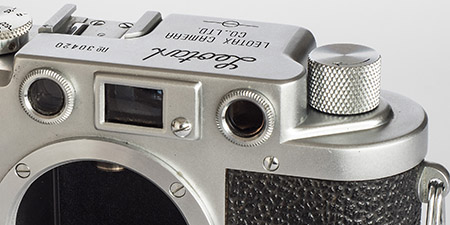
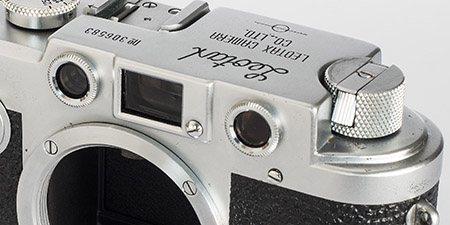
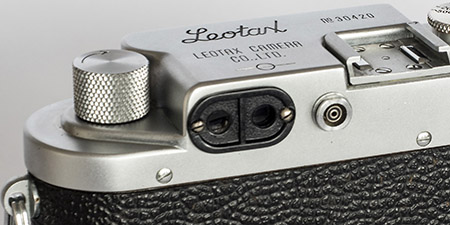
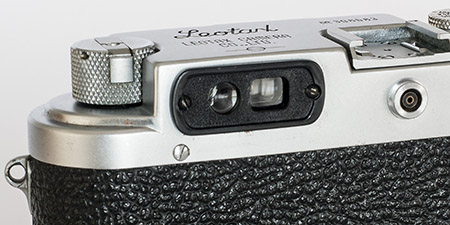
Note also the relocated flash sync socket and the removal of the middle one of the three retaining screws on the back of the top plate.
Although the changes weren't earth shattering and didn't bring a unified viewfinder/rangefinder window, it is a nicer viewfinder than its predecessors, than any Nicca except the III-L and all Leicas up to and including the IIIf. The big changes came with the Leotax G, see that model.
The TV2 user manual tells us that the rangefinder has a base length of 38.2 mm and a magnification of 1.5 times giving an “effective base length” (EBL) of 58 mm. Except it doesn't quite compute, EBL = base length x magnification = 57.3 mm, or conversely, 58 mm / 1.5 = 38.67 mm. As far as I can make out, my Leotax K (F generation) rangefinder is the same as my TV2. I don't have specs for the Leotax G but the magnification with the combined viewfinder was certain to be less than 1.5 times (the Leica M3 was 0.92x, the Nikon SP 1x) and the base length looks shorter.
Leica III models have a 39 mm base and 1.5 times magnification giving an EBL of 58.5 mm. (Note, early examples of the the stamped body Leotax D IV have “1.5x” engraved between the eyepieces, presumably indicating the magnification of the rangefinder is 1.5 times suggesting that on earlier models it may have been 1x like the Leica II and rivals Nippon and Nicca Original.)
Shutter Speed Dials
Before the die-cast models arrived with the Leotax F, shutter dials were easy. If there were slow speeds, the “20” changeover speed was at the end of the slow speed dial and the dial was secured by a large screw until it was hidden on the Leotax D IV onward. There was no shutter lock. The main dial started with the German “Z” (zeit) before changing to “B” (bulb) on both the late D III with the interim maker name “Showa Optical Company limited” and the special NR III version of the D III. If there were slow speeds, the numbers started with “20-1” meaning that as well as the 1/20 speed, it was the position for the main dial when using any of the slow speeds. If there were no slow speeds, the numbers started with “20”.
Except for the Leotax K without slow speeds and the final Leotax G model which has no separate slow speed dial, the die-cast models feature a slow speed shutter dial lock and the changeover speed is located in the middle of the speeds like the Leica IIIf. Of course, there is an exception, the Leotax K3 which only has two slow speeds on its dial. This also affects the main dial which instead of the “30-1” changeover speed, is marked simply “30” because there is no “1” for one second on the slow speed dial.
The Leotax F introduced red coloured changeover speeds to both shutter dials of the 1st generation die-cast models. The Leotax TV changed the colour of the changeover speed on the main dial and all slow speeds to green for the 2nd and 3rd generation models . In some instances, the colour may be very hard to see, not just in photos but in real life, there could be some degradation over time.
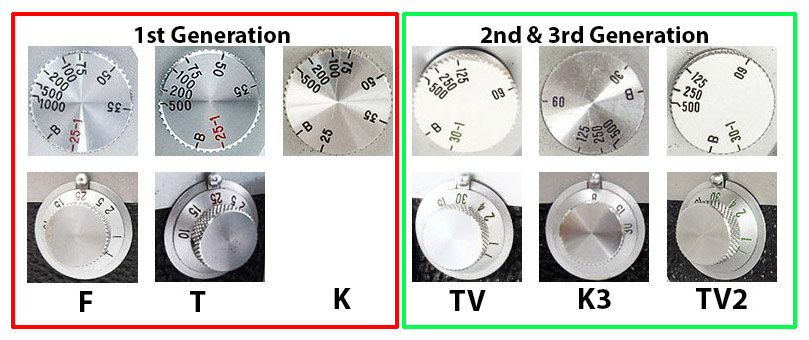
From left to right above. On both the Leotax F and T, the new changeover speed of 1/25 was marked in red on both dials (“25-1” and “25”). The Leotax K didn't feature slow speeds so there is no changeover speed and its first speed is “25” in standard black. With the adoption of the modern geometric speeds, the 2nd generation die-cast Leotax TV increased the changeover speed to 1/30 and changed the colour on the main dial from red to green and all slow speeds also to green. This continued until the end. Except for omitting the “T” setting, the T2 (not shown) features the same dials. As mentioned earlier, because of its reduced speeds, the Leotax K3 gets a simple “30” instead of “30-1” on its main dial but it is still green even though the above numerals appear to be black. The TV2 dials are the same as the earlier TV and, except for a couple of speeds, the same as the FV (adds “1000”) and T2L Elite (omits “T”).
Flash Sync
There is a lot of misunderstanding about flash synchronisation, sync for short, particularly for most of us that have lived principally in an electronic flash world (I'm old enough to have relied on flash bulbs in my childhood and teenage years). I have noticed this not only with Leotax but also with my earlier research into the Yashica YE and YF and Nicca.
Keeping it simple, different flash bulb classes have different delay times (the milliseconds from burn starting to shutter firing) and different burn characteristics. Leica with its first synchronised camera, the IIIf, whilst effective, made it very complicated with different delay times set by a dial under the shutter. Other cameras with focal plane shutters, including the rangefinder brands I just mentioned, have made it far easier.
Basically, an electronic flash fires instantaneously and the duration is far shorter than any shutter speed so it can only be used at the point when the two curtains of a Leica type focal plane shutter are fully open at the same time, not at higher speeds where the slit between the two curtains as they travel across the film plane is always narrower than the exposure area. With cloth focal plane shutters from the time, the highest speed both curtains are fully open is usually at the changeover speed between the low and high speeds so that is normally the X sync speed (with the exception of the Nicca Type 33 which syncs at 1/60 rather than the 1/30 changeover). With the slow speeds, there is an escapement which adds a time delay to one of the curtains so the time period that both curtains are fully open is even longer, obviously electronic flash can be used at those speeds too, as can most flash bulbs, including “M” class (medium time to peak, 18-24 milliseconds), unless there is an unusual or excessively long time delay.
Flash bulbs have a much longer burn time than electronic flash but they usually build up to a short peak and then quickly drop off so if you used an M class bulb, for example, for exposures faster than X sync speed, the exposure would be very uneven from one side to the other. “FP” (meaning “focal plane”) bulbs have a medium delay (16-18 milliseconds to reach half peak), long duration and wide flat peak (maintained at over half intensity for at least 25 milliseconds) so that they are suitable for the higher speeds including the 1/1000 (the curtains travel at the same speed, it is the slit that varies).
In that context, in regard to the F/X sync switch, the Leotax F user manual says “for strobe or speed class bulbs, use X”. By now, you should realise that “F” stands for “FP” and not “flashbulb” as one site currently suggests, or like Nikon, it could it could stand for the fast shutter speeds which still require FP bulbs. So for all other bulbs, also use the X sync position, but according to the user manual, the shutter speed should be set to one of the low speed range, not the X sync speed. Just to confuse the issue, there is also “F” class bulbs and sync. The “F” stands for fast time to peak - it is not related to “FP”. Note, according to Sugiyama, the two coaxial flash sockets on the Leotax S are FP and F, but I'm thinking that it is more like FP for the high shutter speeds and Nikon's “S” for slow shutter speeds where both curtains are fully open and delay and duration don't really matter.
Like Nicca, Leotax had worked out how to automatically switch between FP sync (all speeds above the changeover speed) and X sync (changeover speed and below). It is a common mistake to think that because there is one socket and no switch, sync must be X only. Quite a number of sites have made that claim in regard to the Yashicas, Niccas and Leotaxes including Ian Norris and the great HPR in his book “Leica Copies”. The ad for the Leotax TV and brochures for the Leotax TV2 Merit and T2L Elite make it very clear that switching is automatic. During the whole of the 1950s, the flashbulb was still the principal artificial light source for most photographers.
Accessories
Like other Leica copy makers of the time, Leotax sold its cameras with leather ever-ready cases, sometimes priced separately, and metal lens caps in the box and offered branded filters, lens hoods and reloadable film cassettes. Accessory viewfinders for the wide angle and telephoto lenses are covered in Topcor (Tokyo Kogaku) lenses. As a general comment, accessories didn't seem to be promoted much in period advertising nor do they seem as common these days as Nicca items - perhaps that is more a reflection of Nicca using independent distributor Hinomaruya which may have had a vested interest in some of the items, its name certainly appearing on boxes, containers and even early lens hoods. Below is a typical Leotax lens hood with its case and a filter (types and sizes are covered further below):
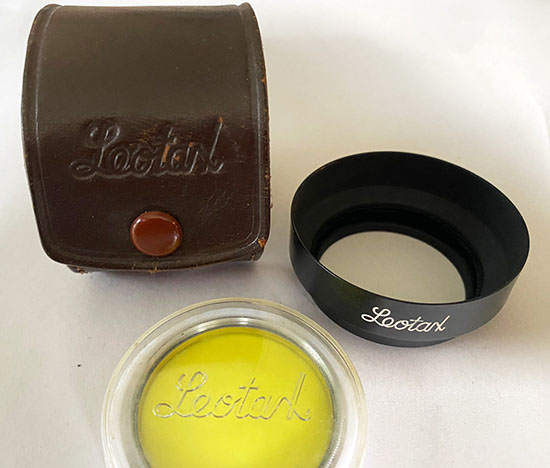 (Image courtesy of Gary Hill)
(Image courtesy of Gary Hill)
Lens Caps
These were the obligatory silver metal types with embossed name. The Leotax name appeared on all the standard 5cm lenses lens caps but the two telephotos and wide angle retained their Topcor names. This is the 36 mm version:

Ever-ready Cases
The leather ever-ready cases changed style over time. As with other Leica copy makers, early cases such as this Leotax Special case, reflected Leica styling and practice with the leather neck strap passing through leather saddles on the case and under the camera:

(Detail from larger web image)
The Special D III Case updated the “Leotax” name style on the snout:

(Detail from larger web image)
The example below is for the last early body types, the Leotax D IV and Leotax S. Its leather neck strap now passes through two leather saddles each side instead of one. The S version has a cut-out in the half-case for the two sync sockets:
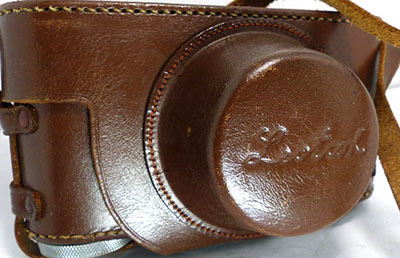
(Detail from larger web image)
This is the case for the first version of the first die-cast models, the Leotax F and Leotax T with the ASA window in the film wind knob (I haven't yet seen any Ts yet with this first style film type reminder but there are a number of Ks with the window and the same style bottom half-case). It's similar to the previous case, but larger for the new body, has a cut-out for the sync switch, the neck strap now passes through one saddle only and is then riveted to the side of the case and replaces the bottom press studs of the top/front half with a metal hinge. There is a knob for sliding the hinge pin to separate the two halves. Note, the blacked in “Leotax” name is not original:



(Images courtesy of Bruce Thomas)
Both the early and late versions of the Leotax K cases are the same as the F versions except that they have a squared off snout. This is the early version with the same hinge and strap arrangement as above:

(Detail from larger web image)
Below left is the case style used by later versions of the F and T, and on the right, the Leotax K. The leather saddles have disappeared and both now feature metal neck strap attachment points but the new hinge connection of the top/front half has been replaced by three press studs in a more typically traditional arrangement (a revised hinge will reappear with the TV and successors):
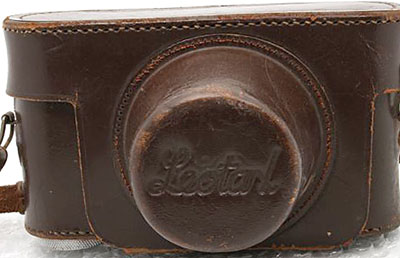

(Detail from larger web images)
The press studs of a late Leotax F case:
 (Detail from larger web image)
(Detail from larger web image)
Below is a late Leotax T case which demonstrates the different shape of the half-case cut-out for the sync switch compared to the early style cut-out of the Leotax F further above:
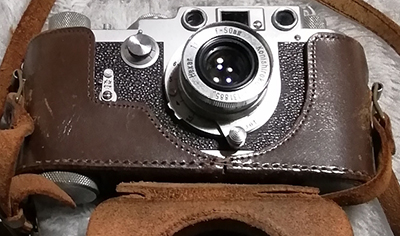 (Detail from larger web image)
(Detail from larger web image)
The cases for the second generation Leotax TV based models and third generation Leotax FV based models are basically the same as each other but one difference is the neck strap mounting points, simple leather secured loops on the earlier types and the chrome and leather bracket of the later examples like this one:
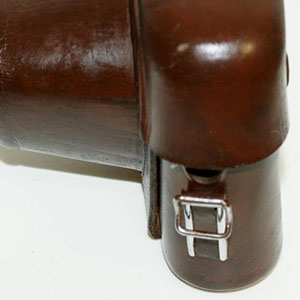 (Detail from larger web image)
(Detail from larger web image)
The case below was found with an FV generation Merite box but the strap mounting points are like the earlier TV type. Note the return of the detachable metal hinge in the bottom photo, now updated and featuring two release knobs:

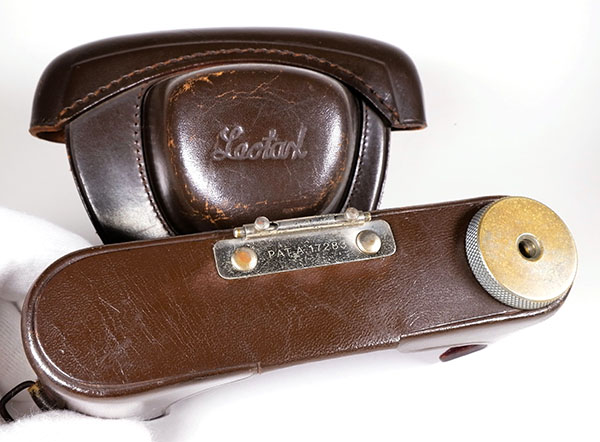
(Images courtesy of Chris Whelan)
Whilst the metal hinge appears to be unique to the Leotax, the overall look though is very similar to this Leica M3 case:
 (Detail from larger web image)
(Detail from larger web image)
The Leotax G case is quite different to earlier Leotax cases and the one above but has a passing similarity to another Leica style, possibly a later M3 case, the main differences being that the Leica doesn't feature the chrome trim and the rim of the snout, instead of sitting on top of the front piece, sits under the cut-out like the M3 case above and the Leotax one above that. The case on the left below shows slightly more of the top but it is hard to see that the name written as “Leotax” everywhere else has now become “LeoTax”, although not on the box or camera or anywhere else that I can find:
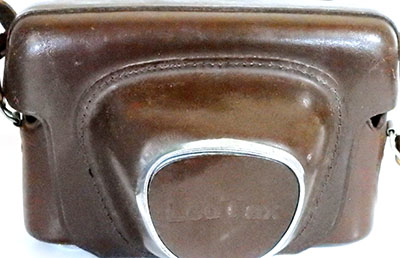
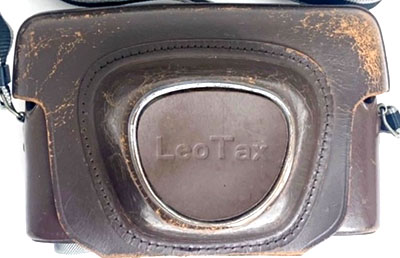
(Detail from larger web images)
Reloadable Film Cassettes
Like Leitz, most copy makers and others in that period, Leotax offered a reloadable 35 mm film cassette. Well, actually two types. In general, they fit better than disposable cassettes, which are shorter, and may make winding feel smoother because there is no friction inducing felt light seal but there seem to be few real problems with modern cassettes - see “Loading Film” under Operation on the YE & YF page.
This one is the first type and as is expected, is inspired by the Leica FILCA type. It looks much like the Nicca/Yashica version except that instead of the white “C” for “close” on top they still use the German “Z” for “zu”. It is designed for the early stamped Leotax bodies up to and including the Leotax S:
 (Detail from larger web image)
(Detail from larger web image)
Operation and background of this style of cassette is covered here. It was supplied in a plain aluminium version of the also Leica inspired cannister below:
The cassette below is Zeiss Ikon Contax inspired and will only work with the new base plate locking mechanism introduced with the die-cast models, starting with the Leotax F. It operates a little differently. Instead of the external spring and pin arrangement, on top are two adjacent cylindrical knobs, one of which is fixed and performs the slot opening function of the “mushroom” in the above type and the other operates an internal spring which moves a part of the external track into line with a slot in the casting on the side to allow the casing to be fully rotated and removed:
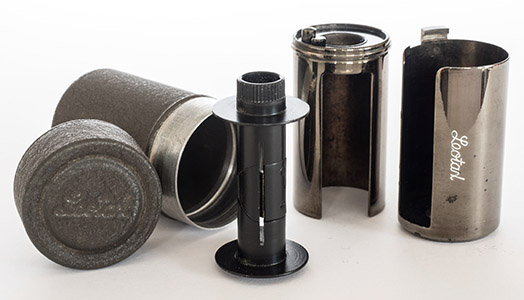

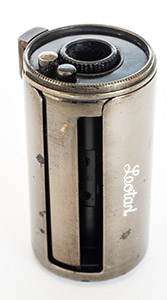
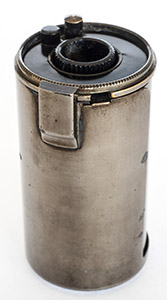
This example in a typical burnished bronze like finish was supplied in a dark grey-brown hammertone painted aluminium canister with embossed “Leotax” on top, although I have seen light grey painted ones too for both early and late type cassettes. The style of canister didn't seem to change with cassette type. Light grey canister:
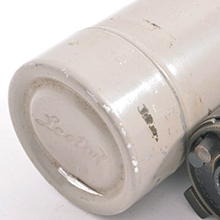 (Detail from larger web image)
(Detail from larger web image)
Rather than the burnished bronze finish, this cassette is finished in black enamel. Another one like it is pictured with a complete Leotax T2L set and its papers suggesting that it is a late variation. This one was found with a plain black Bakelite canister but it is not possible to know whether it is original to the cassette or not:
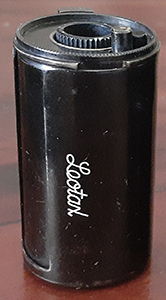 (Image courtesy of Bruce Thomas)
(Image courtesy of Bruce Thomas)
Filters
Leotax offered branded filters but the range of types and sizes is not known:

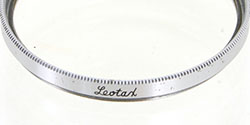 (Detail from larger web images)
(Detail from larger web images)
Yellow 34 mm filter and UV 40.5 mm filter.
In regard to the 5 cm normal lenses, the most common thread size is 40.5 mm which takes care of the Topcor f/1.5, Topcor f/2, the three iterations of the Topcor-S f/2, the Topcor f/1.8, the three Leonons, the later version of the Hexanon f/1.9 and the Fujinon f/2.8. The Fujinon f/2 is 43 mm.
The various collapsible f/3.5 lenses take 36 mm push-on type filters and both the late Tessar type Topcor and Hexar collapsible f/3.5s are also threaded for screw-in filters. The Hexar has a 34.5 mm filter thread whilst I believe that the Topcor is 34 mm. The rigid f/3.5 Topcor lenses are also likely to take 36 mm push-on and 34 mm screw-in filters.
The Topcor f/2.8 lens has a 34 mm filter thread.
The tricky ones are the f/1.5 Simlar with a 40 mm filter thread and the earlier Hexanon which is 39.5 mm.
Lens Hoods
As with filters, there are quite a few sizes to cover. Most of them screw into the lens filter threads so use the filter sizes above as a guide. One exception is the Fujinon f/2 which uses a 45 mm clamp on hood. The f/3.5 lenses take 36 mm push-on/clamp on hoods and the Topcor f/2.8 came with its own dedicated hood.
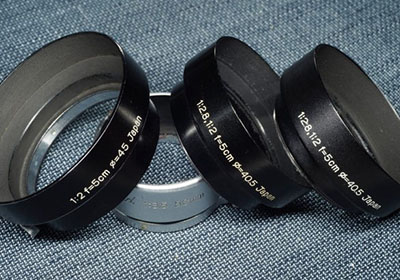
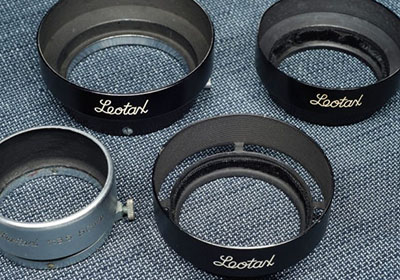
(Detail from excellent Japanese website KoiWide featuring lens hoods for many models)
Flashgun
The Leotax F, T, TV and TV2 user manuals below do not display, nor mention, flashguns apart from providing sync information. They don't appear in any of the more recent advertising or brochures. Clearly, there seems to be little evidence demonstrated by Leotax of interest in offering, or at least marketing, their own brand flashgun. But it wasn't always thus. A circa 1953 brochure insert featuring the Leotax S refers to using the “Leotax small B.C.B flash”. The main brochure features the Leotax D IV, Semi Leotax and the “Leotax Flash Model B.C.B” mounted on a Semi Leotax:
 (Detail from Camera-wiki.org brochure)
(Detail from Camera-wiki.org brochure)
User Manuals
(Note for MacOS users only: Safari is sometimes displaying only the left half of double page scanned PDFs if the first scan is a single page - common with my cover pages, eg. Chris Whelan's TV2 manual below. Suggest using different browser, or Preview, instead.)
The English language Leotax F manual is available for download from the Mike Butkus site.
Below is the Japanese Leotax T manual (originally downloaded from a Japanese site where it is no longer available):
Below is the Japanese Leotax TV manual (also originally downloaded from the above site):
Contributor Chris Whelan has kindly scanned his Japanese Leotax TV2 (later Merite) manual and made it available to be displayed here:
.jpg) (Manual scan courtesy of Chris Whelan)
(Manual scan courtesy of Chris Whelan)
(Click on cover for PDF)
1957 Prices
The US Department of Commerce booklet, The Development of the Japanese Photographic Products Industry, 1954-1958, lists Japanese retail prices of a number of Leotax models and competitors as at 31 March 1957. To that, I have added the Leotax F with Topcor f/1.5 lens and a different price with the f/2 Topcor found in a 1956 Asahi Camera magazine ad:
| Camera Make & Model |
Lens | Aperture | Price |
|---|---|---|---|
| US Department of Commerce 31 March 1957 | |||
| Leotax F | Topcor | f/2 | ¥52,000 |
| Leotax F | Hexanon | f/1.9 | ¥52,000 |
| Leotax F | Topcor (collapsible) | f/3.5 | ¥38,500 |
| Leotax T | Hexar (collapsible) | f/3.5 | ¥35,000 |
| Leotax K | Topcor (rigid) | f/3.5 | ¥26,000 |
| Nicca 3-F | Nikkor | f/2 | ¥49,500 |
| Canon L2 | Canon | f/1.8 | ¥69,000 |
| Leotax Ad 1956 | |||
| Leotax F | Topcor | f/1.5 | ¥65,000 |
| Leotax F | Topcor | f/2 | ¥48,500 |
The Leotax models are all first generation die-cast models based on the Leotax F body. The Nicca 3-F was the knob wind body but the lever wind was released at the same price. Whilst its specs were similar to the Leotax F with f/2 lens, the Nicca features a top speed of 1/500 versus the Leotax model's 1/1000, perhaps reflected in the relative 1957 prices. The 1956 price reflects the large aperture f/1.5 Topcor lens. The Canon L2 is a more modern hinged back model but was a budget camera in Canon's hierarchy with a top speed of 1/500 and X flash sync omitted. Clearly, the Leotax and Nicca were competing with Canon more on price than features, or system possibilities.
The Biggest & Heaviest
Leotax models have long been reputed to be the biggest and heaviest, and by implication, strongest of the Japanese Leica copies. There was a lot more similarity between the earlier stamped body sizes so I'm going to focus on the later die-cast models only and only those that still look like a screw mount Leica, not the Leotax G nor Nicca III-L. Let's also note that the equivalent Leica models are lighter and smaller than the Japanese models and the build quality is second to none so size and weight may, or may not, be important quality indicators.
Leaving aside the Minolta 35 which cannot be said to look like one, Leotax was the first Japanese maker to introduce a die-cast body based on the Leica IIIc/f. The Leica was already bigger and heavier than its stamped body ancestors and as the Leotax F was bigger than the Leica, it became the biggest and heaviest Japanese Leica copy by default. When the Nicca Type-5 arrived 12 months later, the differences narrowed somewhat , although the Leotaxes certainly remained heavier. The Type-5 is not a good comparison as the rear flap adds 15 grams.
Below is a table featuring the Leica IIIc/f as the baseline inspiration, three Leotax models representing the three generations of die-cast models and two from Nicca (sort of), the staple 3-F knob wind and filling in for the 3-F lever wind, the Yashica YE which construction-wise is identical.
| Dimension | Leica IIIc/f |
Leotax K |
Leotax TV |
Leotax TV2 |
Nicca 3F |
Yashica YE |
|---|---|---|---|---|---|---|
Base Plate Length |
135mm |
140mm |
140mm |
140mm |
139mm |
139mm |
Camera Height |
69mm |
72mm |
72mm |
72mm |
71mm |
73mm |
Base Plate Width |
30mm |
32mm |
32mm |
32mm |
31mm |
31mm |
Body Weight |
425/430gm |
490gm |
498gm |
493gm |
448gm |
472gm |
Note: These measurements (rounded to the nearest millimetre) and weights are indicative only. Camera height is to the top of the viewfinder. The Leica IIIc, Leotaxes, Nicca and the Yashica are as measured and weighed by me, the Leica IIIf by correspondent Terry Byford.
Below is the Leotax K going toe to toe with the Leica IIIc. The increase in camera width is noticeable:
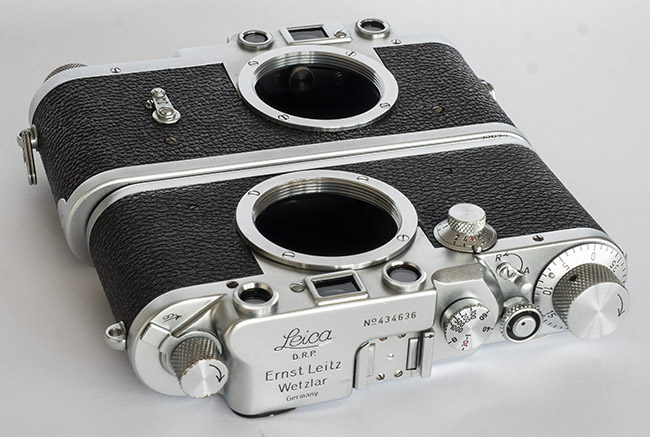
Visually, the size differences between the Japanese models are harder to spot because of different visual cues. The surprising thing for me is that there is just 8 grams between the Leotax models and the lever wind TV2 weighs less than basically the same camera with knob wind (TV).
Contact Details
My name is Paul Sokk and I can be contacted by email at paulsokk@live.com.au.
.jpg)
.jpg)